Occupational Health and Safety Risk Control in Construction Projects among Construction Workers in Melbourne
VerifiedAdded on 2023/06/11
|18
|4332
|203
AI Summary
This paper explores the risk associated with construction sites in terms accidents and health hazards. The paper emphasizes on the role of the management commitment, workers’ attitude, and effectiveness of safety policies in ensuring the health and safety of workers at the construction sites. The aim of this study is to explore occupational health and safety risks that construction workers in Melbourne are exposed to by focusing on issues of management safety standards and commitment, workers’ awareness on safety issues, and their attitudes.
Contribute Materials
Your contribution can guide someone’s learning journey. Share your
documents today.
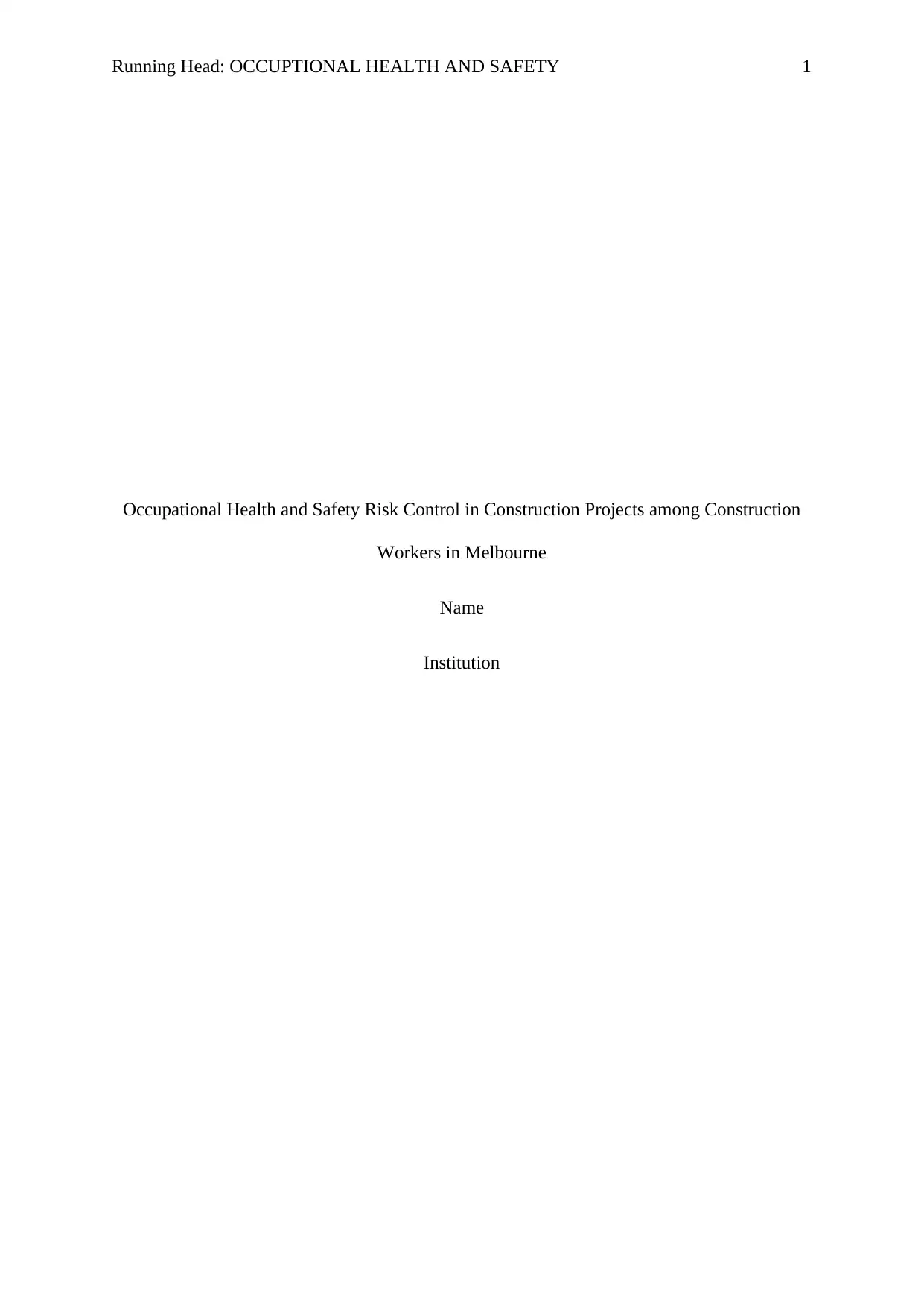
Running Head: OCCUPTIONAL HEALTH AND SAFETY 1
Occupational Health and Safety Risk Control in Construction Projects among Construction
Workers in Melbourne
Name
Institution
Occupational Health and Safety Risk Control in Construction Projects among Construction
Workers in Melbourne
Name
Institution
Secure Best Marks with AI Grader
Need help grading? Try our AI Grader for instant feedback on your assignments.
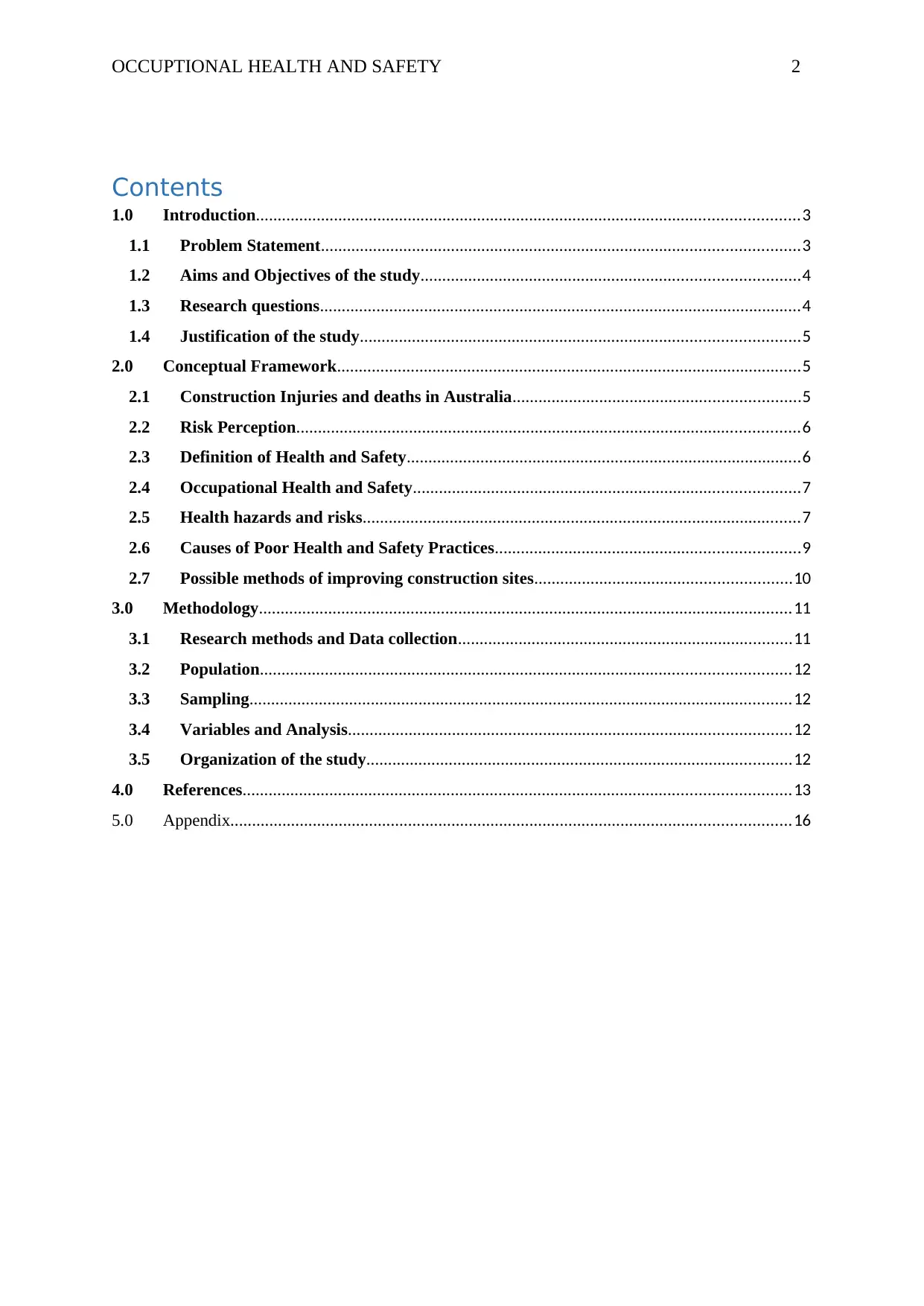
OCCUPTIONAL HEALTH AND SAFETY 2
Contents
1.0 Introduction.............................................................................................................................3
1.1 Problem Statement..............................................................................................................3
1.2 Aims and Objectives of the study.......................................................................................4
1.3 Research questions...............................................................................................................4
1.4 Justification of the study.....................................................................................................5
2.0 Conceptual Framework...........................................................................................................5
2.1 Construction Injuries and deaths in Australia..................................................................5
2.2 Risk Perception....................................................................................................................6
2.3 Definition of Health and Safety...........................................................................................6
2.4 Occupational Health and Safety.........................................................................................7
2.5 Health hazards and risks.....................................................................................................7
2.6 Causes of Poor Health and Safety Practices......................................................................9
2.7 Possible methods of improving construction sites...........................................................10
3.0 Methodology...........................................................................................................................11
3.1 Research methods and Data collection.............................................................................11
3.2 Population..........................................................................................................................12
3.3 Sampling.............................................................................................................................12
3.4 Variables and Analysis......................................................................................................12
3.5 Organization of the study..................................................................................................12
4.0 References..............................................................................................................................13
5.0 Appendix.................................................................................................................................16
Contents
1.0 Introduction.............................................................................................................................3
1.1 Problem Statement..............................................................................................................3
1.2 Aims and Objectives of the study.......................................................................................4
1.3 Research questions...............................................................................................................4
1.4 Justification of the study.....................................................................................................5
2.0 Conceptual Framework...........................................................................................................5
2.1 Construction Injuries and deaths in Australia..................................................................5
2.2 Risk Perception....................................................................................................................6
2.3 Definition of Health and Safety...........................................................................................6
2.4 Occupational Health and Safety.........................................................................................7
2.5 Health hazards and risks.....................................................................................................7
2.6 Causes of Poor Health and Safety Practices......................................................................9
2.7 Possible methods of improving construction sites...........................................................10
3.0 Methodology...........................................................................................................................11
3.1 Research methods and Data collection.............................................................................11
3.2 Population..........................................................................................................................12
3.3 Sampling.............................................................................................................................12
3.4 Variables and Analysis......................................................................................................12
3.5 Organization of the study..................................................................................................12
4.0 References..............................................................................................................................13
5.0 Appendix.................................................................................................................................16
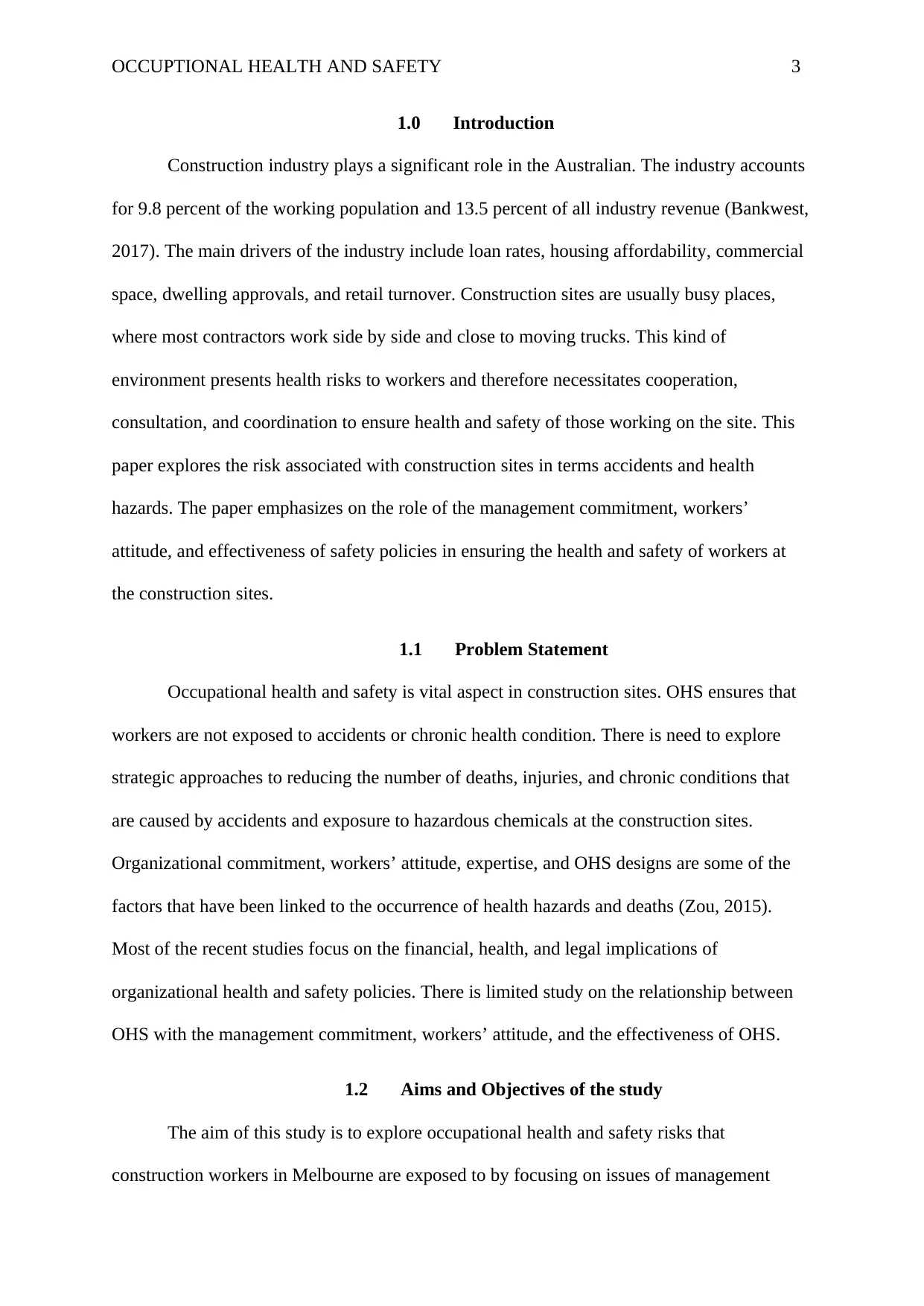
OCCUPTIONAL HEALTH AND SAFETY 3
1.0 Introduction
Construction industry plays a significant role in the Australian. The industry accounts
for 9.8 percent of the working population and 13.5 percent of all industry revenue (Bankwest,
2017). The main drivers of the industry include loan rates, housing affordability, commercial
space, dwelling approvals, and retail turnover. Construction sites are usually busy places,
where most contractors work side by side and close to moving trucks. This kind of
environment presents health risks to workers and therefore necessitates cooperation,
consultation, and coordination to ensure health and safety of those working on the site. This
paper explores the risk associated with construction sites in terms accidents and health
hazards. The paper emphasizes on the role of the management commitment, workers’
attitude, and effectiveness of safety policies in ensuring the health and safety of workers at
the construction sites.
1.1 Problem Statement
Occupational health and safety is vital aspect in construction sites. OHS ensures that
workers are not exposed to accidents or chronic health condition. There is need to explore
strategic approaches to reducing the number of deaths, injuries, and chronic conditions that
are caused by accidents and exposure to hazardous chemicals at the construction sites.
Organizational commitment, workers’ attitude, expertise, and OHS designs are some of the
factors that have been linked to the occurrence of health hazards and deaths (Zou, 2015).
Most of the recent studies focus on the financial, health, and legal implications of
organizational health and safety policies. There is limited study on the relationship between
OHS with the management commitment, workers’ attitude, and the effectiveness of OHS.
1.2 Aims and Objectives of the study
The aim of this study is to explore occupational health and safety risks that
construction workers in Melbourne are exposed to by focusing on issues of management
1.0 Introduction
Construction industry plays a significant role in the Australian. The industry accounts
for 9.8 percent of the working population and 13.5 percent of all industry revenue (Bankwest,
2017). The main drivers of the industry include loan rates, housing affordability, commercial
space, dwelling approvals, and retail turnover. Construction sites are usually busy places,
where most contractors work side by side and close to moving trucks. This kind of
environment presents health risks to workers and therefore necessitates cooperation,
consultation, and coordination to ensure health and safety of those working on the site. This
paper explores the risk associated with construction sites in terms accidents and health
hazards. The paper emphasizes on the role of the management commitment, workers’
attitude, and effectiveness of safety policies in ensuring the health and safety of workers at
the construction sites.
1.1 Problem Statement
Occupational health and safety is vital aspect in construction sites. OHS ensures that
workers are not exposed to accidents or chronic health condition. There is need to explore
strategic approaches to reducing the number of deaths, injuries, and chronic conditions that
are caused by accidents and exposure to hazardous chemicals at the construction sites.
Organizational commitment, workers’ attitude, expertise, and OHS designs are some of the
factors that have been linked to the occurrence of health hazards and deaths (Zou, 2015).
Most of the recent studies focus on the financial, health, and legal implications of
organizational health and safety policies. There is limited study on the relationship between
OHS with the management commitment, workers’ attitude, and the effectiveness of OHS.
1.2 Aims and Objectives of the study
The aim of this study is to explore occupational health and safety risks that
construction workers in Melbourne are exposed to by focusing on issues of management
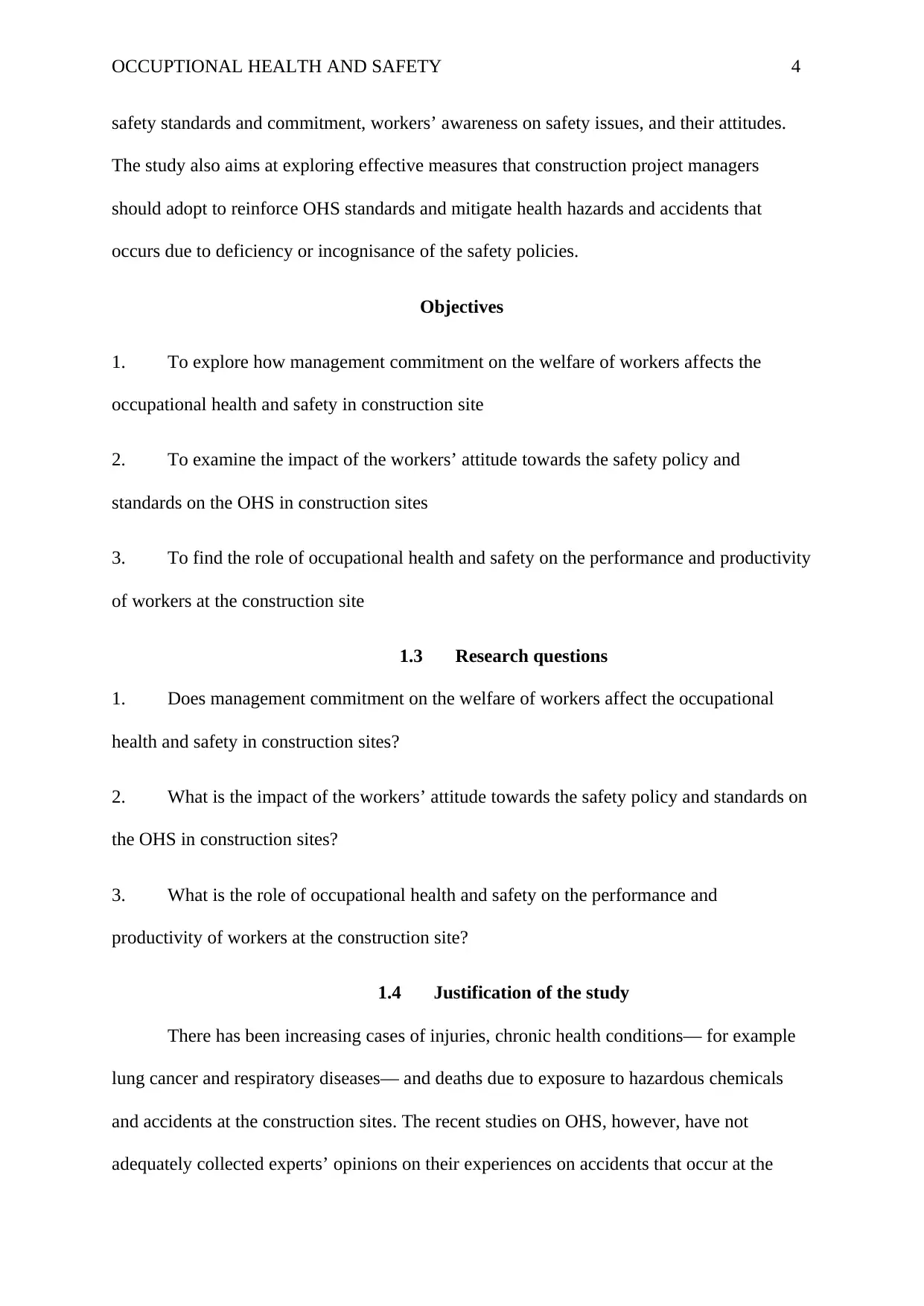
OCCUPTIONAL HEALTH AND SAFETY 4
safety standards and commitment, workers’ awareness on safety issues, and their attitudes.
The study also aims at exploring effective measures that construction project managers
should adopt to reinforce OHS standards and mitigate health hazards and accidents that
occurs due to deficiency or incognisance of the safety policies.
Objectives
1. To explore how management commitment on the welfare of workers affects the
occupational health and safety in construction site
2. To examine the impact of the workers’ attitude towards the safety policy and
standards on the OHS in construction sites
3. To find the role of occupational health and safety on the performance and productivity
of workers at the construction site
1.3 Research questions
1. Does management commitment on the welfare of workers affect the occupational
health and safety in construction sites?
2. What is the impact of the workers’ attitude towards the safety policy and standards on
the OHS in construction sites?
3. What is the role of occupational health and safety on the performance and
productivity of workers at the construction site?
1.4 Justification of the study
There has been increasing cases of injuries, chronic health conditions— for example
lung cancer and respiratory diseases— and deaths due to exposure to hazardous chemicals
and accidents at the construction sites. The recent studies on OHS, however, have not
adequately collected experts’ opinions on their experiences on accidents that occur at the
safety standards and commitment, workers’ awareness on safety issues, and their attitudes.
The study also aims at exploring effective measures that construction project managers
should adopt to reinforce OHS standards and mitigate health hazards and accidents that
occurs due to deficiency or incognisance of the safety policies.
Objectives
1. To explore how management commitment on the welfare of workers affects the
occupational health and safety in construction site
2. To examine the impact of the workers’ attitude towards the safety policy and
standards on the OHS in construction sites
3. To find the role of occupational health and safety on the performance and productivity
of workers at the construction site
1.3 Research questions
1. Does management commitment on the welfare of workers affect the occupational
health and safety in construction sites?
2. What is the impact of the workers’ attitude towards the safety policy and standards on
the OHS in construction sites?
3. What is the role of occupational health and safety on the performance and
productivity of workers at the construction site?
1.4 Justification of the study
There has been increasing cases of injuries, chronic health conditions— for example
lung cancer and respiratory diseases— and deaths due to exposure to hazardous chemicals
and accidents at the construction sites. The recent studies on OHS, however, have not
adequately collected experts’ opinions on their experiences on accidents that occur at the
Secure Best Marks with AI Grader
Need help grading? Try our AI Grader for instant feedback on your assignments.
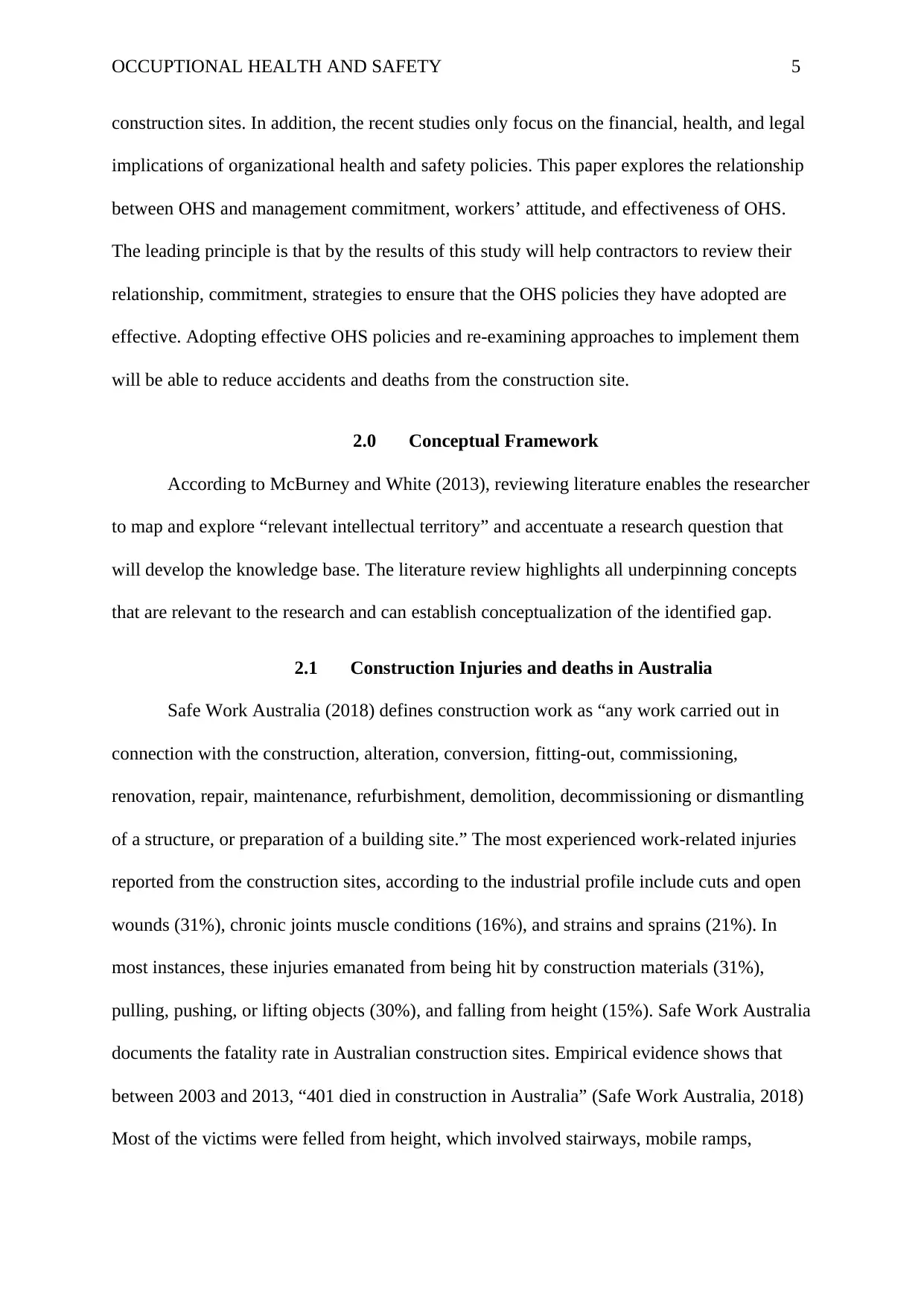
OCCUPTIONAL HEALTH AND SAFETY 5
construction sites. In addition, the recent studies only focus on the financial, health, and legal
implications of organizational health and safety policies. This paper explores the relationship
between OHS and management commitment, workers’ attitude, and effectiveness of OHS.
The leading principle is that by the results of this study will help contractors to review their
relationship, commitment, strategies to ensure that the OHS policies they have adopted are
effective. Adopting effective OHS policies and re-examining approaches to implement them
will be able to reduce accidents and deaths from the construction site.
2.0 Conceptual Framework
According to McBurney and White (2013), reviewing literature enables the researcher
to map and explore “relevant intellectual territory” and accentuate a research question that
will develop the knowledge base. The literature review highlights all underpinning concepts
that are relevant to the research and can establish conceptualization of the identified gap.
2.1 Construction Injuries and deaths in Australia
Safe Work Australia (2018) defines construction work as “any work carried out in
connection with the construction, alteration, conversion, fitting-out, commissioning,
renovation, repair, maintenance, refurbishment, demolition, decommissioning or dismantling
of a structure, or preparation of a building site.” The most experienced work-related injuries
reported from the construction sites, according to the industrial profile include cuts and open
wounds (31%), chronic joints muscle conditions (16%), and strains and sprains (21%). In
most instances, these injuries emanated from being hit by construction materials (31%),
pulling, pushing, or lifting objects (30%), and falling from height (15%). Safe Work Australia
documents the fatality rate in Australian construction sites. Empirical evidence shows that
between 2003 and 2013, “401 died in construction in Australia” (Safe Work Australia, 2018)
Most of the victims were felled from height, which involved stairways, mobile ramps,
construction sites. In addition, the recent studies only focus on the financial, health, and legal
implications of organizational health and safety policies. This paper explores the relationship
between OHS and management commitment, workers’ attitude, and effectiveness of OHS.
The leading principle is that by the results of this study will help contractors to review their
relationship, commitment, strategies to ensure that the OHS policies they have adopted are
effective. Adopting effective OHS policies and re-examining approaches to implement them
will be able to reduce accidents and deaths from the construction site.
2.0 Conceptual Framework
According to McBurney and White (2013), reviewing literature enables the researcher
to map and explore “relevant intellectual territory” and accentuate a research question that
will develop the knowledge base. The literature review highlights all underpinning concepts
that are relevant to the research and can establish conceptualization of the identified gap.
2.1 Construction Injuries and deaths in Australia
Safe Work Australia (2018) defines construction work as “any work carried out in
connection with the construction, alteration, conversion, fitting-out, commissioning,
renovation, repair, maintenance, refurbishment, demolition, decommissioning or dismantling
of a structure, or preparation of a building site.” The most experienced work-related injuries
reported from the construction sites, according to the industrial profile include cuts and open
wounds (31%), chronic joints muscle conditions (16%), and strains and sprains (21%). In
most instances, these injuries emanated from being hit by construction materials (31%),
pulling, pushing, or lifting objects (30%), and falling from height (15%). Safe Work Australia
documents the fatality rate in Australian construction sites. Empirical evidence shows that
between 2003 and 2013, “401 died in construction in Australia” (Safe Work Australia, 2018)
Most of the victims were felled from height, which involved stairways, mobile ramps,
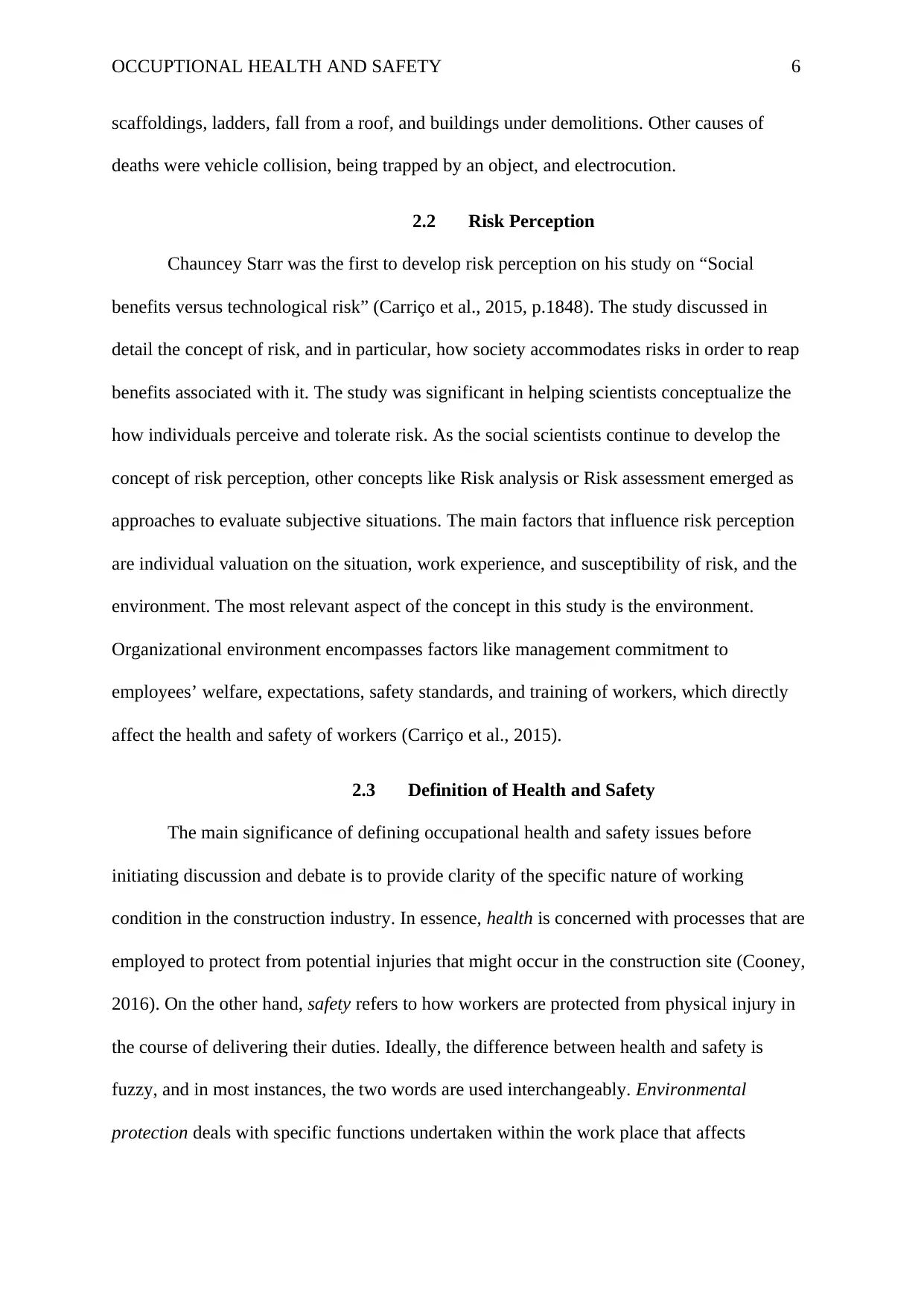
OCCUPTIONAL HEALTH AND SAFETY 6
scaffoldings, ladders, fall from a roof, and buildings under demolitions. Other causes of
deaths were vehicle collision, being trapped by an object, and electrocution.
2.2 Risk Perception
Chauncey Starr was the first to develop risk perception on his study on “Social
benefits versus technological risk” (Carriço et al., 2015, p.1848). The study discussed in
detail the concept of risk, and in particular, how society accommodates risks in order to reap
benefits associated with it. The study was significant in helping scientists conceptualize the
how individuals perceive and tolerate risk. As the social scientists continue to develop the
concept of risk perception, other concepts like Risk analysis or Risk assessment emerged as
approaches to evaluate subjective situations. The main factors that influence risk perception
are individual valuation on the situation, work experience, and susceptibility of risk, and the
environment. The most relevant aspect of the concept in this study is the environment.
Organizational environment encompasses factors like management commitment to
employees’ welfare, expectations, safety standards, and training of workers, which directly
affect the health and safety of workers (Carriço et al., 2015).
2.3 Definition of Health and Safety
The main significance of defining occupational health and safety issues before
initiating discussion and debate is to provide clarity of the specific nature of working
condition in the construction industry. In essence, health is concerned with processes that are
employed to protect from potential injuries that might occur in the construction site (Cooney,
2016). On the other hand, safety refers to how workers are protected from physical injury in
the course of delivering their duties. Ideally, the difference between health and safety is
fuzzy, and in most instances, the two words are used interchangeably. Environmental
protection deals with specific functions undertaken within the work place that affects
scaffoldings, ladders, fall from a roof, and buildings under demolitions. Other causes of
deaths were vehicle collision, being trapped by an object, and electrocution.
2.2 Risk Perception
Chauncey Starr was the first to develop risk perception on his study on “Social
benefits versus technological risk” (Carriço et al., 2015, p.1848). The study discussed in
detail the concept of risk, and in particular, how society accommodates risks in order to reap
benefits associated with it. The study was significant in helping scientists conceptualize the
how individuals perceive and tolerate risk. As the social scientists continue to develop the
concept of risk perception, other concepts like Risk analysis or Risk assessment emerged as
approaches to evaluate subjective situations. The main factors that influence risk perception
are individual valuation on the situation, work experience, and susceptibility of risk, and the
environment. The most relevant aspect of the concept in this study is the environment.
Organizational environment encompasses factors like management commitment to
employees’ welfare, expectations, safety standards, and training of workers, which directly
affect the health and safety of workers (Carriço et al., 2015).
2.3 Definition of Health and Safety
The main significance of defining occupational health and safety issues before
initiating discussion and debate is to provide clarity of the specific nature of working
condition in the construction industry. In essence, health is concerned with processes that are
employed to protect from potential injuries that might occur in the construction site (Cooney,
2016). On the other hand, safety refers to how workers are protected from physical injury in
the course of delivering their duties. Ideally, the difference between health and safety is
fuzzy, and in most instances, the two words are used interchangeably. Environmental
protection deals with specific functions undertaken within the work place that affects
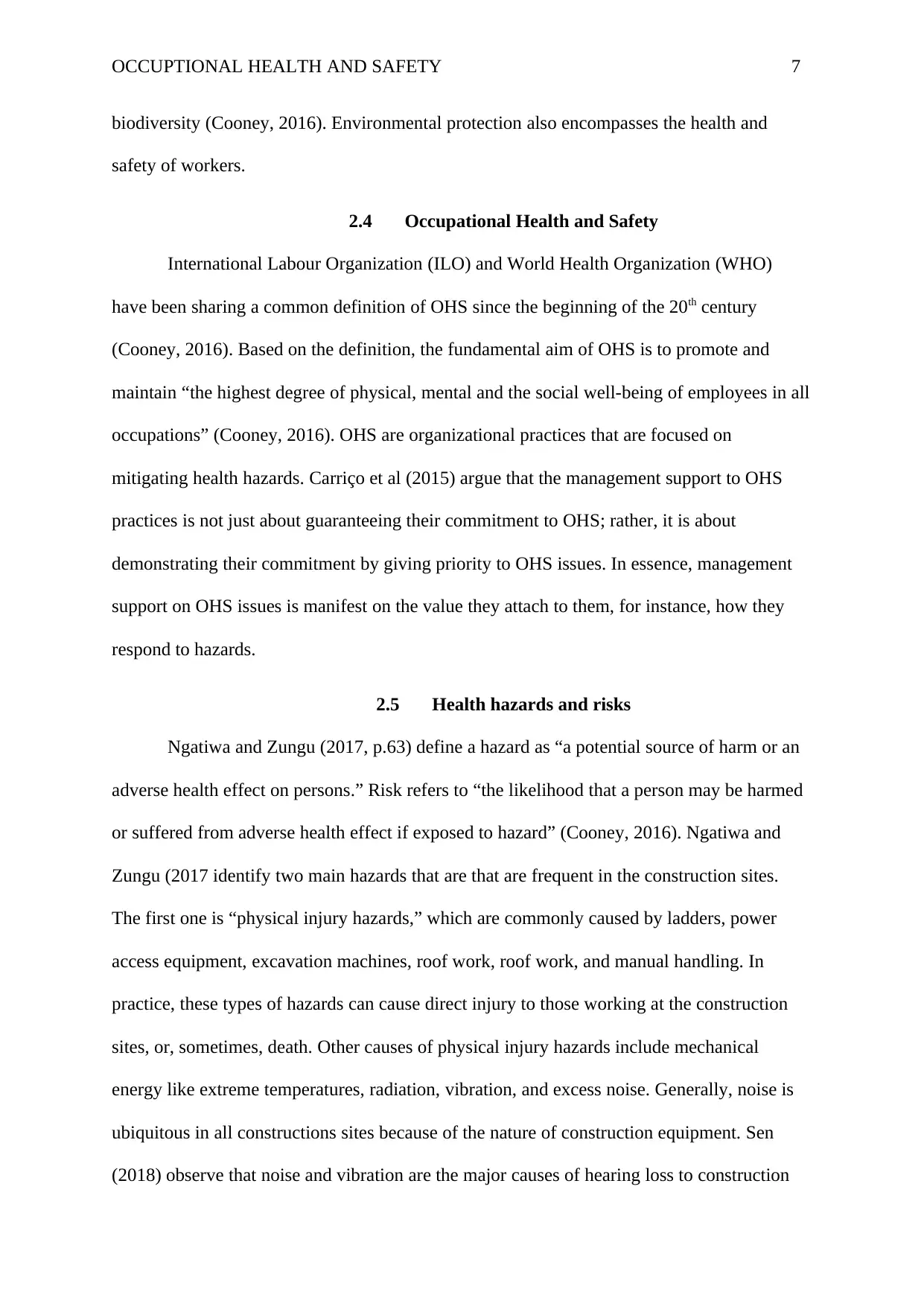
OCCUPTIONAL HEALTH AND SAFETY 7
biodiversity (Cooney, 2016). Environmental protection also encompasses the health and
safety of workers.
2.4 Occupational Health and Safety
International Labour Organization (ILO) and World Health Organization (WHO)
have been sharing a common definition of OHS since the beginning of the 20th century
(Cooney, 2016). Based on the definition, the fundamental aim of OHS is to promote and
maintain “the highest degree of physical, mental and the social well-being of employees in all
occupations” (Cooney, 2016). OHS are organizational practices that are focused on
mitigating health hazards. Carriço et al (2015) argue that the management support to OHS
practices is not just about guaranteeing their commitment to OHS; rather, it is about
demonstrating their commitment by giving priority to OHS issues. In essence, management
support on OHS issues is manifest on the value they attach to them, for instance, how they
respond to hazards.
2.5 Health hazards and risks
Ngatiwa and Zungu (2017, p.63) define a hazard as “a potential source of harm or an
adverse health effect on persons.” Risk refers to “the likelihood that a person may be harmed
or suffered from adverse health effect if exposed to hazard” (Cooney, 2016). Ngatiwa and
Zungu (2017 identify two main hazards that are that are frequent in the construction sites.
The first one is “physical injury hazards,” which are commonly caused by ladders, power
access equipment, excavation machines, roof work, roof work, and manual handling. In
practice, these types of hazards can cause direct injury to those working at the construction
sites, or, sometimes, death. Other causes of physical injury hazards include mechanical
energy like extreme temperatures, radiation, vibration, and excess noise. Generally, noise is
ubiquitous in all constructions sites because of the nature of construction equipment. Sen
(2018) observe that noise and vibration are the major causes of hearing loss to construction
biodiversity (Cooney, 2016). Environmental protection also encompasses the health and
safety of workers.
2.4 Occupational Health and Safety
International Labour Organization (ILO) and World Health Organization (WHO)
have been sharing a common definition of OHS since the beginning of the 20th century
(Cooney, 2016). Based on the definition, the fundamental aim of OHS is to promote and
maintain “the highest degree of physical, mental and the social well-being of employees in all
occupations” (Cooney, 2016). OHS are organizational practices that are focused on
mitigating health hazards. Carriço et al (2015) argue that the management support to OHS
practices is not just about guaranteeing their commitment to OHS; rather, it is about
demonstrating their commitment by giving priority to OHS issues. In essence, management
support on OHS issues is manifest on the value they attach to them, for instance, how they
respond to hazards.
2.5 Health hazards and risks
Ngatiwa and Zungu (2017, p.63) define a hazard as “a potential source of harm or an
adverse health effect on persons.” Risk refers to “the likelihood that a person may be harmed
or suffered from adverse health effect if exposed to hazard” (Cooney, 2016). Ngatiwa and
Zungu (2017 identify two main hazards that are that are frequent in the construction sites.
The first one is “physical injury hazards,” which are commonly caused by ladders, power
access equipment, excavation machines, roof work, roof work, and manual handling. In
practice, these types of hazards can cause direct injury to those working at the construction
sites, or, sometimes, death. Other causes of physical injury hazards include mechanical
energy like extreme temperatures, radiation, vibration, and excess noise. Generally, noise is
ubiquitous in all constructions sites because of the nature of construction equipment. Sen
(2018) observe that noise and vibration are the major causes of hearing loss to construction
Paraphrase This Document
Need a fresh take? Get an instant paraphrase of this document with our AI Paraphraser
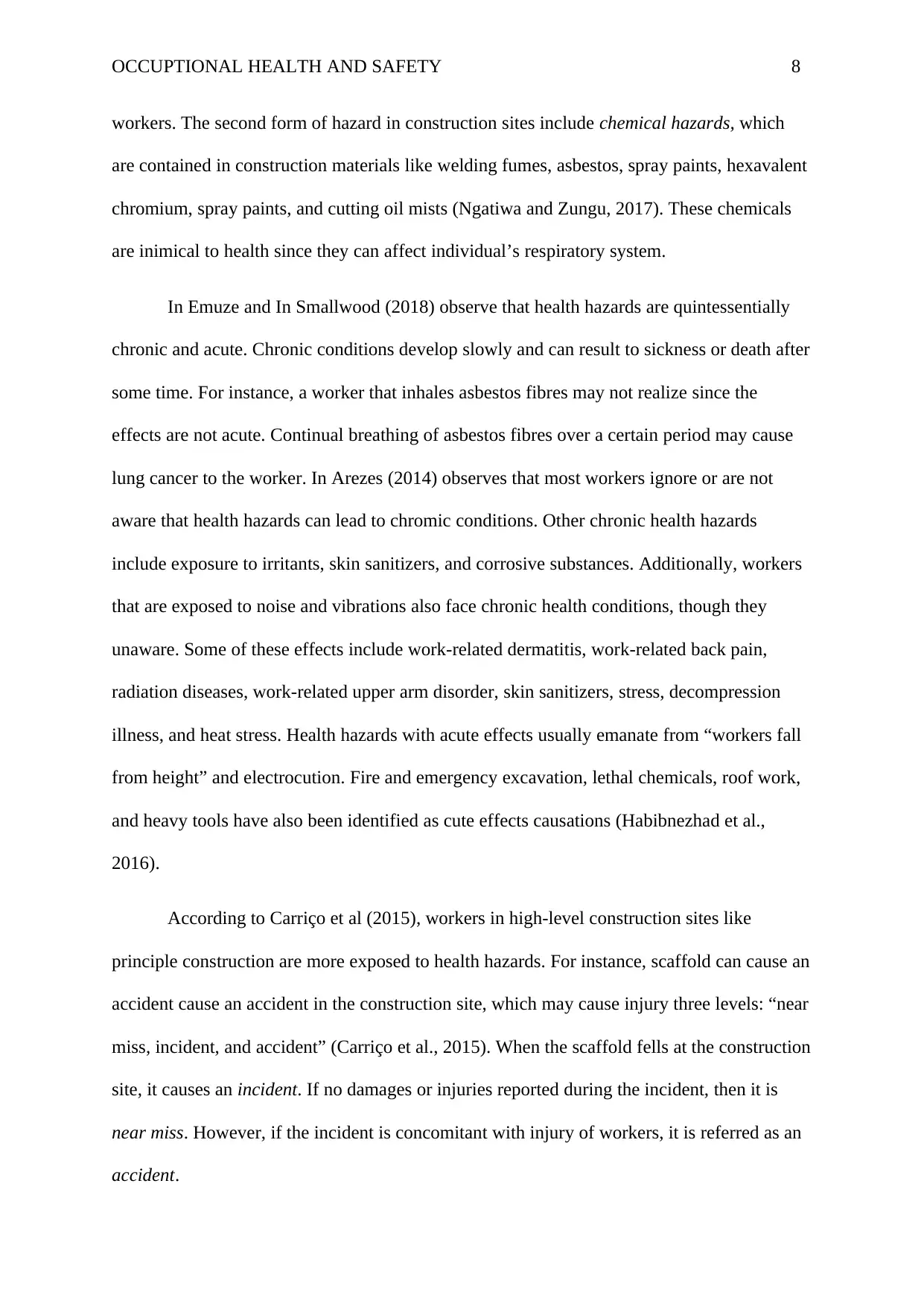
OCCUPTIONAL HEALTH AND SAFETY 8
workers. The second form of hazard in construction sites include chemical hazards, which
are contained in construction materials like welding fumes, asbestos, spray paints, hexavalent
chromium, spray paints, and cutting oil mists (Ngatiwa and Zungu, 2017). These chemicals
are inimical to health since they can affect individual’s respiratory system.
In Emuze and In Smallwood (2018) observe that health hazards are quintessentially
chronic and acute. Chronic conditions develop slowly and can result to sickness or death after
some time. For instance, a worker that inhales asbestos fibres may not realize since the
effects are not acute. Continual breathing of asbestos fibres over a certain period may cause
lung cancer to the worker. In Arezes (2014) observes that most workers ignore or are not
aware that health hazards can lead to chromic conditions. Other chronic health hazards
include exposure to irritants, skin sanitizers, and corrosive substances. Additionally, workers
that are exposed to noise and vibrations also face chronic health conditions, though they
unaware. Some of these effects include work-related dermatitis, work-related back pain,
radiation diseases, work-related upper arm disorder, skin sanitizers, stress, decompression
illness, and heat stress. Health hazards with acute effects usually emanate from “workers fall
from height” and electrocution. Fire and emergency excavation, lethal chemicals, roof work,
and heavy tools have also been identified as cute effects causations (Habibnezhad et al.,
2016).
According to Carriço et al (2015), workers in high-level construction sites like
principle construction are more exposed to health hazards. For instance, scaffold can cause an
accident cause an accident in the construction site, which may cause injury three levels: “near
miss, incident, and accident” (Carriço et al., 2015). When the scaffold fells at the construction
site, it causes an incident. If no damages or injuries reported during the incident, then it is
near miss. However, if the incident is concomitant with injury of workers, it is referred as an
accident.
workers. The second form of hazard in construction sites include chemical hazards, which
are contained in construction materials like welding fumes, asbestos, spray paints, hexavalent
chromium, spray paints, and cutting oil mists (Ngatiwa and Zungu, 2017). These chemicals
are inimical to health since they can affect individual’s respiratory system.
In Emuze and In Smallwood (2018) observe that health hazards are quintessentially
chronic and acute. Chronic conditions develop slowly and can result to sickness or death after
some time. For instance, a worker that inhales asbestos fibres may not realize since the
effects are not acute. Continual breathing of asbestos fibres over a certain period may cause
lung cancer to the worker. In Arezes (2014) observes that most workers ignore or are not
aware that health hazards can lead to chromic conditions. Other chronic health hazards
include exposure to irritants, skin sanitizers, and corrosive substances. Additionally, workers
that are exposed to noise and vibrations also face chronic health conditions, though they
unaware. Some of these effects include work-related dermatitis, work-related back pain,
radiation diseases, work-related upper arm disorder, skin sanitizers, stress, decompression
illness, and heat stress. Health hazards with acute effects usually emanate from “workers fall
from height” and electrocution. Fire and emergency excavation, lethal chemicals, roof work,
and heavy tools have also been identified as cute effects causations (Habibnezhad et al.,
2016).
According to Carriço et al (2015), workers in high-level construction sites like
principle construction are more exposed to health hazards. For instance, scaffold can cause an
accident cause an accident in the construction site, which may cause injury three levels: “near
miss, incident, and accident” (Carriço et al., 2015). When the scaffold fells at the construction
site, it causes an incident. If no damages or injuries reported during the incident, then it is
near miss. However, if the incident is concomitant with injury of workers, it is referred as an
accident.
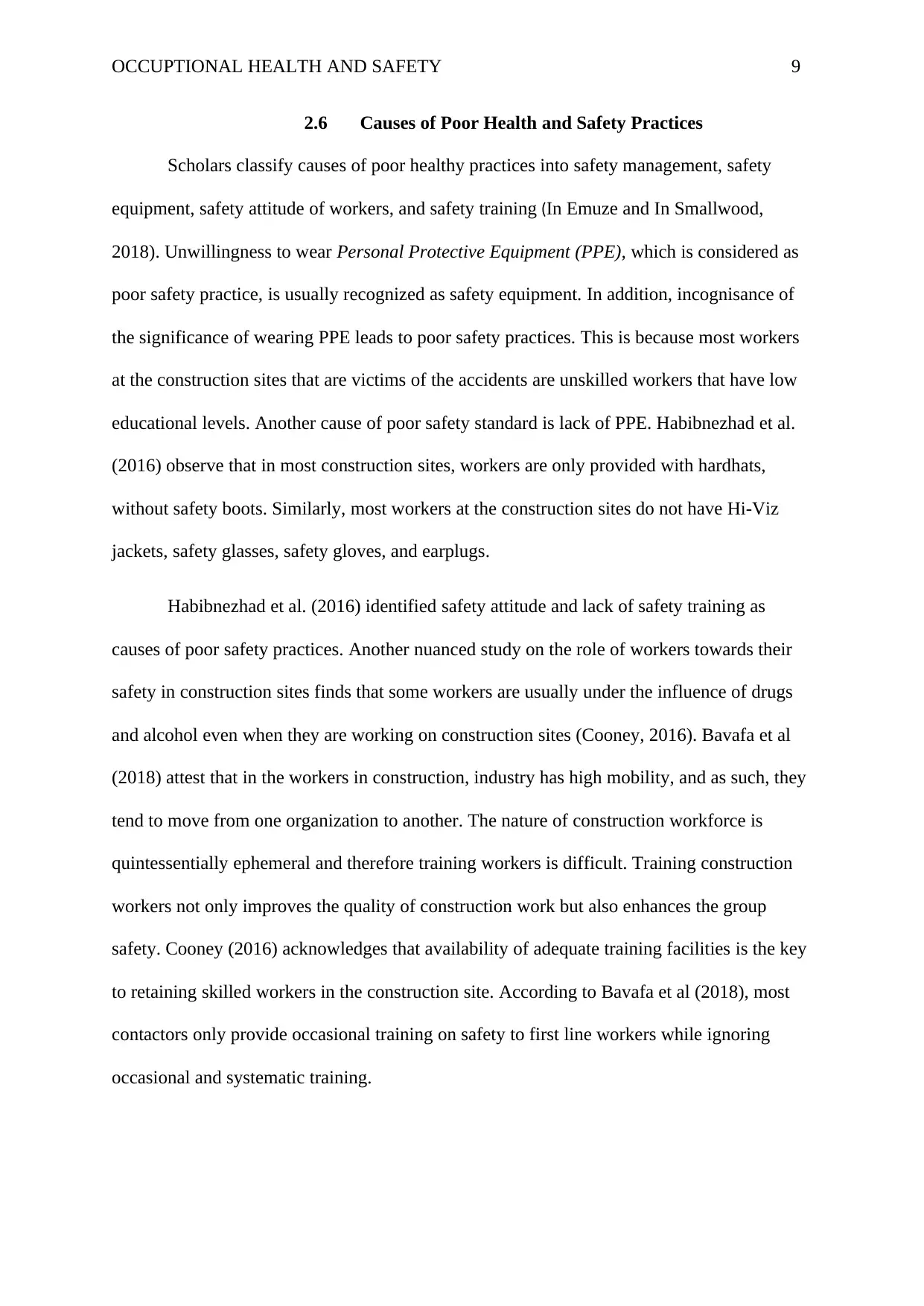
OCCUPTIONAL HEALTH AND SAFETY 9
2.6 Causes of Poor Health and Safety Practices
Scholars classify causes of poor healthy practices into safety management, safety
equipment, safety attitude of workers, and safety training (In Emuze and In Smallwood,
2018). Unwillingness to wear Personal Protective Equipment (PPE), which is considered as
poor safety practice, is usually recognized as safety equipment. In addition, incognisance of
the significance of wearing PPE leads to poor safety practices. This is because most workers
at the construction sites that are victims of the accidents are unskilled workers that have low
educational levels. Another cause of poor safety standard is lack of PPE. Habibnezhad et al.
(2016) observe that in most construction sites, workers are only provided with hardhats,
without safety boots. Similarly, most workers at the construction sites do not have Hi-Viz
jackets, safety glasses, safety gloves, and earplugs.
Habibnezhad et al. (2016) identified safety attitude and lack of safety training as
causes of poor safety practices. Another nuanced study on the role of workers towards their
safety in construction sites finds that some workers are usually under the influence of drugs
and alcohol even when they are working on construction sites (Cooney, 2016). Bavafa et al
(2018) attest that in the workers in construction, industry has high mobility, and as such, they
tend to move from one organization to another. The nature of construction workforce is
quintessentially ephemeral and therefore training workers is difficult. Training construction
workers not only improves the quality of construction work but also enhances the group
safety. Cooney (2016) acknowledges that availability of adequate training facilities is the key
to retaining skilled workers in the construction site. According to Bavafa et al (2018), most
contactors only provide occasional training on safety to first line workers while ignoring
occasional and systematic training.
2.6 Causes of Poor Health and Safety Practices
Scholars classify causes of poor healthy practices into safety management, safety
equipment, safety attitude of workers, and safety training (In Emuze and In Smallwood,
2018). Unwillingness to wear Personal Protective Equipment (PPE), which is considered as
poor safety practice, is usually recognized as safety equipment. In addition, incognisance of
the significance of wearing PPE leads to poor safety practices. This is because most workers
at the construction sites that are victims of the accidents are unskilled workers that have low
educational levels. Another cause of poor safety standard is lack of PPE. Habibnezhad et al.
(2016) observe that in most construction sites, workers are only provided with hardhats,
without safety boots. Similarly, most workers at the construction sites do not have Hi-Viz
jackets, safety glasses, safety gloves, and earplugs.
Habibnezhad et al. (2016) identified safety attitude and lack of safety training as
causes of poor safety practices. Another nuanced study on the role of workers towards their
safety in construction sites finds that some workers are usually under the influence of drugs
and alcohol even when they are working on construction sites (Cooney, 2016). Bavafa et al
(2018) attest that in the workers in construction, industry has high mobility, and as such, they
tend to move from one organization to another. The nature of construction workforce is
quintessentially ephemeral and therefore training workers is difficult. Training construction
workers not only improves the quality of construction work but also enhances the group
safety. Cooney (2016) acknowledges that availability of adequate training facilities is the key
to retaining skilled workers in the construction site. According to Bavafa et al (2018), most
contactors only provide occasional training on safety to first line workers while ignoring
occasional and systematic training.
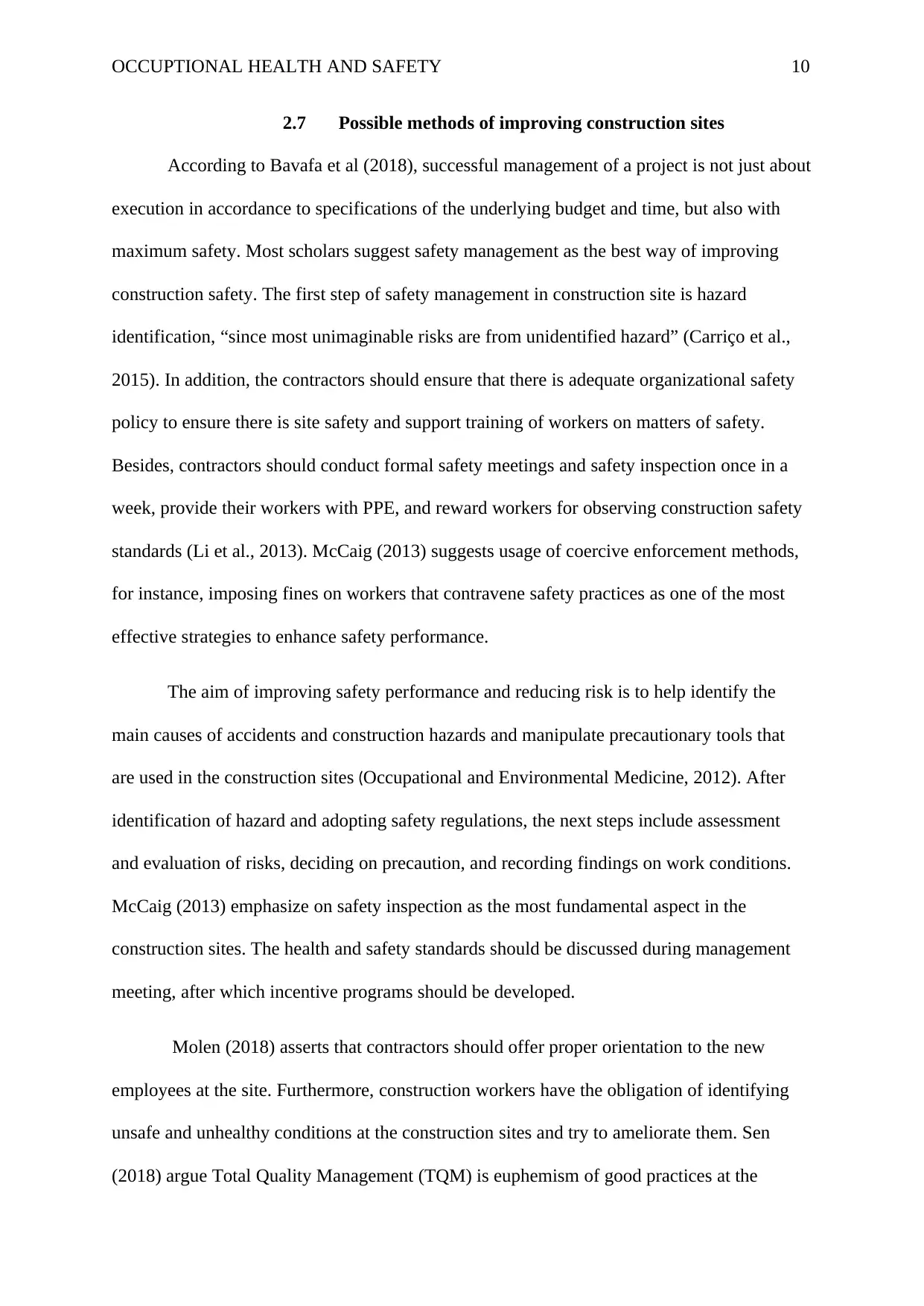
OCCUPTIONAL HEALTH AND SAFETY 10
2.7 Possible methods of improving construction sites
According to Bavafa et al (2018), successful management of a project is not just about
execution in accordance to specifications of the underlying budget and time, but also with
maximum safety. Most scholars suggest safety management as the best way of improving
construction safety. The first step of safety management in construction site is hazard
identification, “since most unimaginable risks are from unidentified hazard” (Carriço et al.,
2015). In addition, the contractors should ensure that there is adequate organizational safety
policy to ensure there is site safety and support training of workers on matters of safety.
Besides, contractors should conduct formal safety meetings and safety inspection once in a
week, provide their workers with PPE, and reward workers for observing construction safety
standards (Li et al., 2013). McCaig (2013) suggests usage of coercive enforcement methods,
for instance, imposing fines on workers that contravene safety practices as one of the most
effective strategies to enhance safety performance.
The aim of improving safety performance and reducing risk is to help identify the
main causes of accidents and construction hazards and manipulate precautionary tools that
are used in the construction sites (Occupational and Environmental Medicine, 2012). After
identification of hazard and adopting safety regulations, the next steps include assessment
and evaluation of risks, deciding on precaution, and recording findings on work conditions.
McCaig (2013) emphasize on safety inspection as the most fundamental aspect in the
construction sites. The health and safety standards should be discussed during management
meeting, after which incentive programs should be developed.
Molen (2018) asserts that contractors should offer proper orientation to the new
employees at the site. Furthermore, construction workers have the obligation of identifying
unsafe and unhealthy conditions at the construction sites and try to ameliorate them. Sen
(2018) argue Total Quality Management (TQM) is euphemism of good practices at the
2.7 Possible methods of improving construction sites
According to Bavafa et al (2018), successful management of a project is not just about
execution in accordance to specifications of the underlying budget and time, but also with
maximum safety. Most scholars suggest safety management as the best way of improving
construction safety. The first step of safety management in construction site is hazard
identification, “since most unimaginable risks are from unidentified hazard” (Carriço et al.,
2015). In addition, the contractors should ensure that there is adequate organizational safety
policy to ensure there is site safety and support training of workers on matters of safety.
Besides, contractors should conduct formal safety meetings and safety inspection once in a
week, provide their workers with PPE, and reward workers for observing construction safety
standards (Li et al., 2013). McCaig (2013) suggests usage of coercive enforcement methods,
for instance, imposing fines on workers that contravene safety practices as one of the most
effective strategies to enhance safety performance.
The aim of improving safety performance and reducing risk is to help identify the
main causes of accidents and construction hazards and manipulate precautionary tools that
are used in the construction sites (Occupational and Environmental Medicine, 2012). After
identification of hazard and adopting safety regulations, the next steps include assessment
and evaluation of risks, deciding on precaution, and recording findings on work conditions.
McCaig (2013) emphasize on safety inspection as the most fundamental aspect in the
construction sites. The health and safety standards should be discussed during management
meeting, after which incentive programs should be developed.
Molen (2018) asserts that contractors should offer proper orientation to the new
employees at the site. Furthermore, construction workers have the obligation of identifying
unsafe and unhealthy conditions at the construction sites and try to ameliorate them. Sen
(2018) argue Total Quality Management (TQM) is euphemism of good practices at the
Secure Best Marks with AI Grader
Need help grading? Try our AI Grader for instant feedback on your assignments.
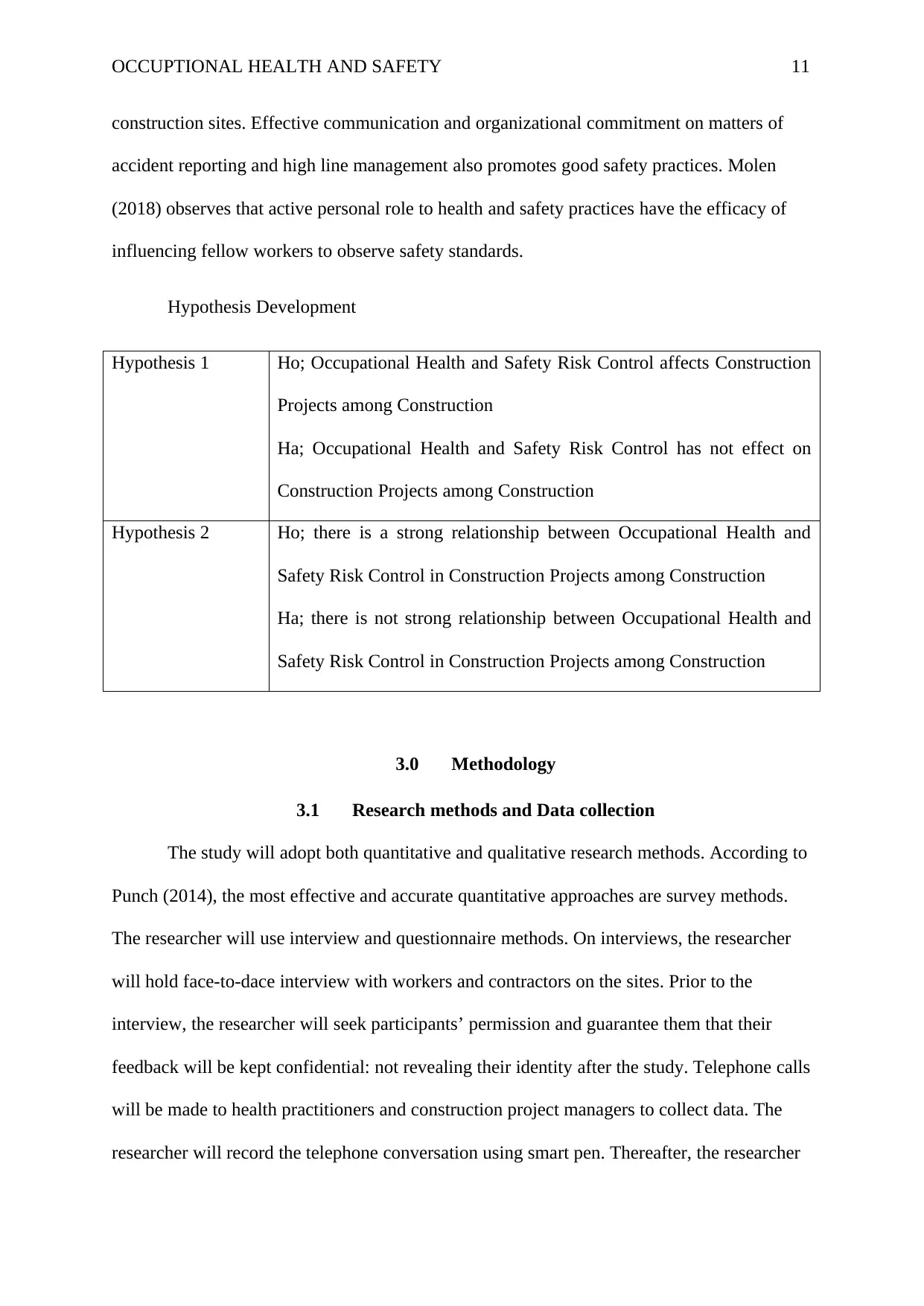
OCCUPTIONAL HEALTH AND SAFETY 11
construction sites. Effective communication and organizational commitment on matters of
accident reporting and high line management also promotes good safety practices. Molen
(2018) observes that active personal role to health and safety practices have the efficacy of
influencing fellow workers to observe safety standards.
Hypothesis Development
Hypothesis 1 Ho; Occupational Health and Safety Risk Control affects Construction
Projects among Construction
Ha; Occupational Health and Safety Risk Control has not effect on
Construction Projects among Construction
Hypothesis 2 Ho; there is a strong relationship between Occupational Health and
Safety Risk Control in Construction Projects among Construction
Ha; there is not strong relationship between Occupational Health and
Safety Risk Control in Construction Projects among Construction
3.0 Methodology
3.1 Research methods and Data collection
The study will adopt both quantitative and qualitative research methods. According to
Punch (2014), the most effective and accurate quantitative approaches are survey methods.
The researcher will use interview and questionnaire methods. On interviews, the researcher
will hold face-to-dace interview with workers and contractors on the sites. Prior to the
interview, the researcher will seek participants’ permission and guarantee them that their
feedback will be kept confidential: not revealing their identity after the study. Telephone calls
will be made to health practitioners and construction project managers to collect data. The
researcher will record the telephone conversation using smart pen. Thereafter, the researcher
construction sites. Effective communication and organizational commitment on matters of
accident reporting and high line management also promotes good safety practices. Molen
(2018) observes that active personal role to health and safety practices have the efficacy of
influencing fellow workers to observe safety standards.
Hypothesis Development
Hypothesis 1 Ho; Occupational Health and Safety Risk Control affects Construction
Projects among Construction
Ha; Occupational Health and Safety Risk Control has not effect on
Construction Projects among Construction
Hypothesis 2 Ho; there is a strong relationship between Occupational Health and
Safety Risk Control in Construction Projects among Construction
Ha; there is not strong relationship between Occupational Health and
Safety Risk Control in Construction Projects among Construction
3.0 Methodology
3.1 Research methods and Data collection
The study will adopt both quantitative and qualitative research methods. According to
Punch (2014), the most effective and accurate quantitative approaches are survey methods.
The researcher will use interview and questionnaire methods. On interviews, the researcher
will hold face-to-dace interview with workers and contractors on the sites. Prior to the
interview, the researcher will seek participants’ permission and guarantee them that their
feedback will be kept confidential: not revealing their identity after the study. Telephone calls
will be made to health practitioners and construction project managers to collect data. The
researcher will record the telephone conversation using smart pen. Thereafter, the researcher
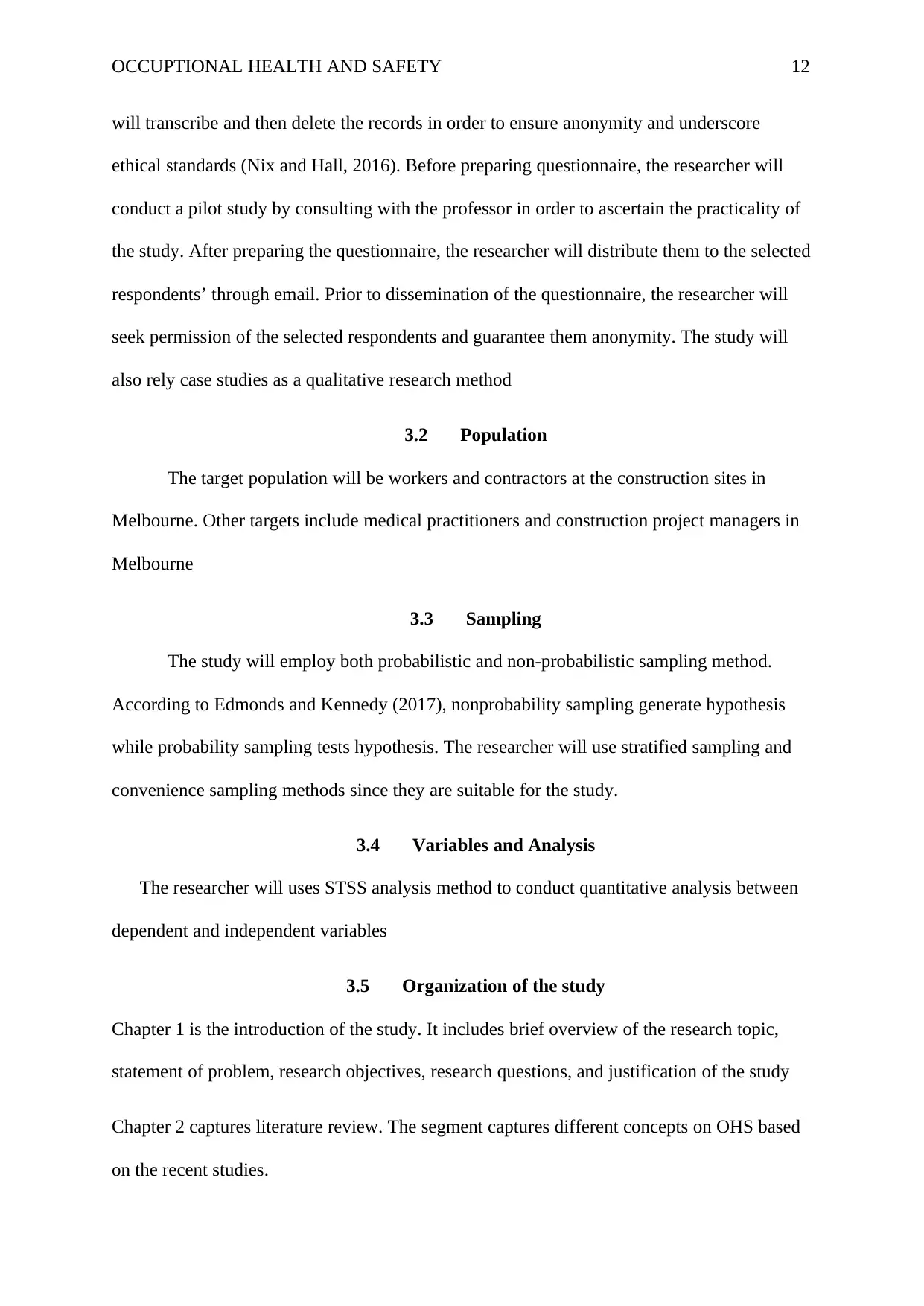
OCCUPTIONAL HEALTH AND SAFETY 12
will transcribe and then delete the records in order to ensure anonymity and underscore
ethical standards (Nix and Hall, 2016). Before preparing questionnaire, the researcher will
conduct a pilot study by consulting with the professor in order to ascertain the practicality of
the study. After preparing the questionnaire, the researcher will distribute them to the selected
respondents’ through email. Prior to dissemination of the questionnaire, the researcher will
seek permission of the selected respondents and guarantee them anonymity. The study will
also rely case studies as a qualitative research method
3.2 Population
The target population will be workers and contractors at the construction sites in
Melbourne. Other targets include medical practitioners and construction project managers in
Melbourne
3.3 Sampling
The study will employ both probabilistic and non-probabilistic sampling method.
According to Edmonds and Kennedy (2017), nonprobability sampling generate hypothesis
while probability sampling tests hypothesis. The researcher will use stratified sampling and
convenience sampling methods since they are suitable for the study.
3.4 Variables and Analysis
The researcher will uses STSS analysis method to conduct quantitative analysis between
dependent and independent variables
3.5 Organization of the study
Chapter 1 is the introduction of the study. It includes brief overview of the research topic,
statement of problem, research objectives, research questions, and justification of the study
Chapter 2 captures literature review. The segment captures different concepts on OHS based
on the recent studies.
will transcribe and then delete the records in order to ensure anonymity and underscore
ethical standards (Nix and Hall, 2016). Before preparing questionnaire, the researcher will
conduct a pilot study by consulting with the professor in order to ascertain the practicality of
the study. After preparing the questionnaire, the researcher will distribute them to the selected
respondents’ through email. Prior to dissemination of the questionnaire, the researcher will
seek permission of the selected respondents and guarantee them anonymity. The study will
also rely case studies as a qualitative research method
3.2 Population
The target population will be workers and contractors at the construction sites in
Melbourne. Other targets include medical practitioners and construction project managers in
Melbourne
3.3 Sampling
The study will employ both probabilistic and non-probabilistic sampling method.
According to Edmonds and Kennedy (2017), nonprobability sampling generate hypothesis
while probability sampling tests hypothesis. The researcher will use stratified sampling and
convenience sampling methods since they are suitable for the study.
3.4 Variables and Analysis
The researcher will uses STSS analysis method to conduct quantitative analysis between
dependent and independent variables
3.5 Organization of the study
Chapter 1 is the introduction of the study. It includes brief overview of the research topic,
statement of problem, research objectives, research questions, and justification of the study
Chapter 2 captures literature review. The segment captures different concepts on OHS based
on the recent studies.
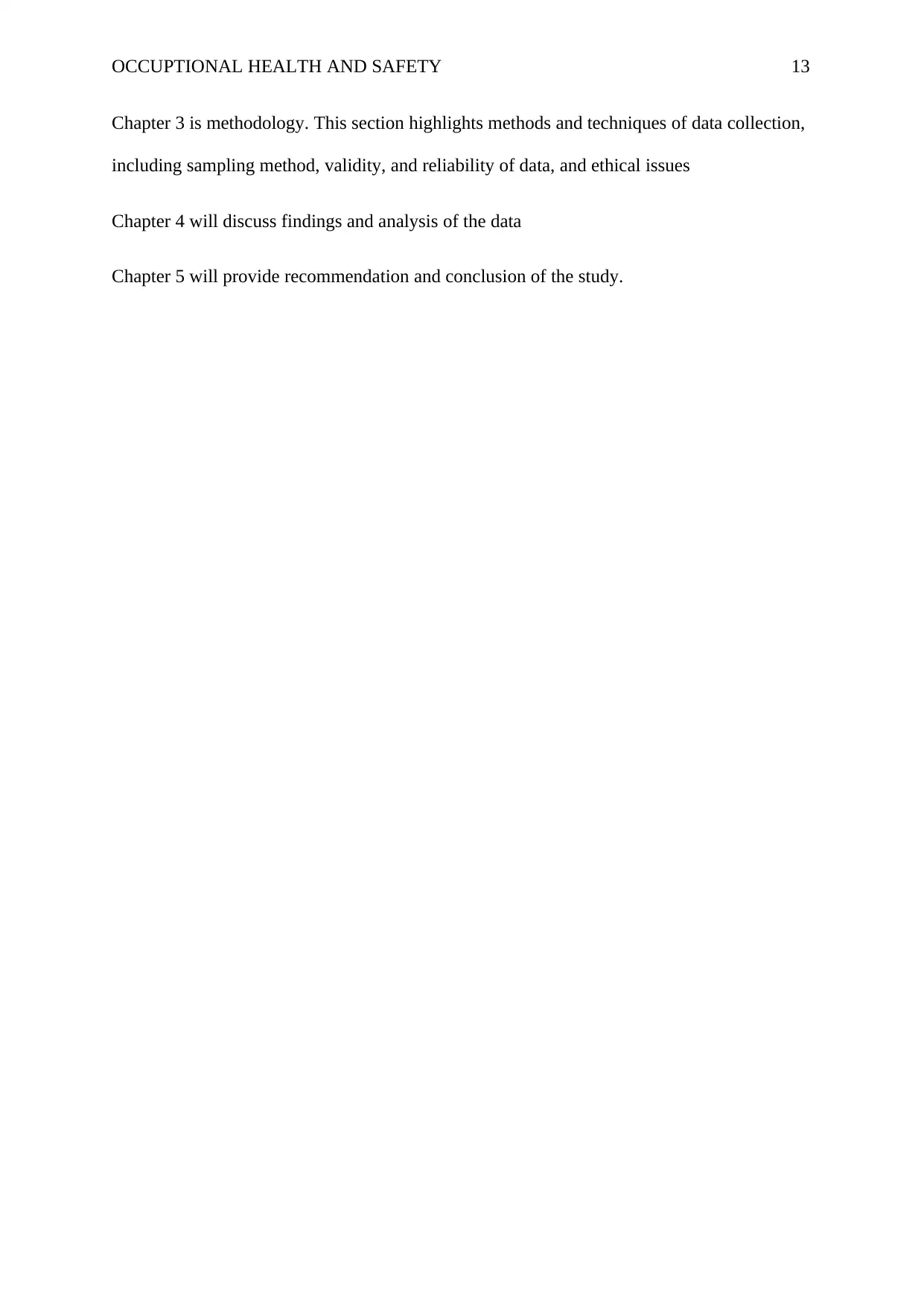
OCCUPTIONAL HEALTH AND SAFETY 13
Chapter 3 is methodology. This section highlights methods and techniques of data collection,
including sampling method, validity, and reliability of data, and ethical issues
Chapter 4 will discuss findings and analysis of the data
Chapter 5 will provide recommendation and conclusion of the study.
Chapter 3 is methodology. This section highlights methods and techniques of data collection,
including sampling method, validity, and reliability of data, and ethical issues
Chapter 4 will discuss findings and analysis of the data
Chapter 5 will provide recommendation and conclusion of the study.
Paraphrase This Document
Need a fresh take? Get an instant paraphrase of this document with our AI Paraphraser
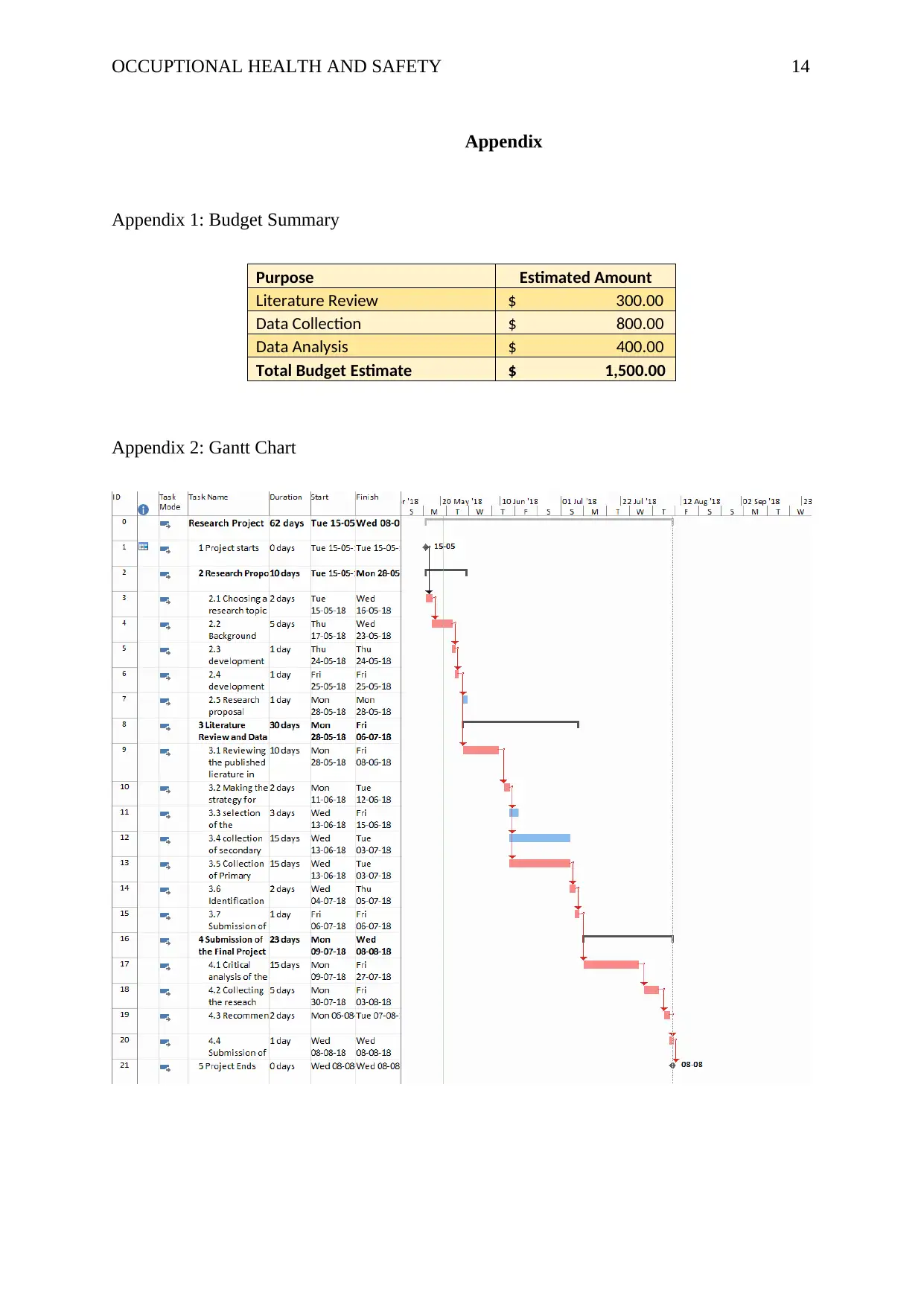
OCCUPTIONAL HEALTH AND SAFETY 14
Appendix
Appendix 1: Budget Summary
Purpose Estimated Amount
Literature Review $ 300.00
Data Collection $ 800.00
Data Analysis $ 400.00
Total Budget Estimate $ 1,500.00
Appendix 2: Gantt Chart
Appendix
Appendix 1: Budget Summary
Purpose Estimated Amount
Literature Review $ 300.00
Data Collection $ 800.00
Data Analysis $ 400.00
Total Budget Estimate $ 1,500.00
Appendix 2: Gantt Chart
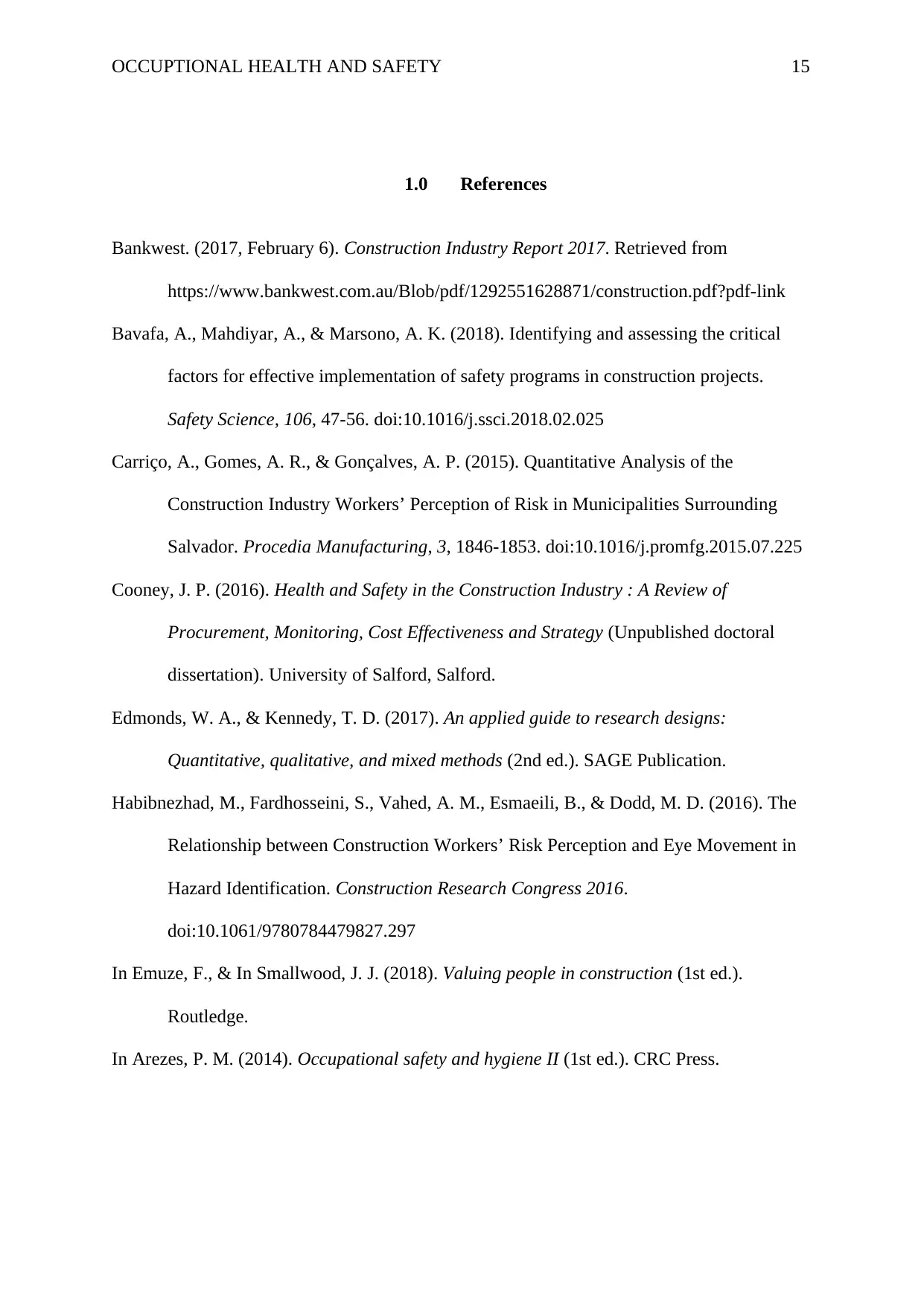
OCCUPTIONAL HEALTH AND SAFETY 15
1.0 References
Bankwest. (2017, February 6). Construction Industry Report 2017. Retrieved from
https://www.bankwest.com.au/Blob/pdf/1292551628871/construction.pdf?pdf-link
Bavafa, A., Mahdiyar, A., & Marsono, A. K. (2018). Identifying and assessing the critical
factors for effective implementation of safety programs in construction projects.
Safety Science, 106, 47-56. doi:10.1016/j.ssci.2018.02.025
Carriço, A., Gomes, A. R., & Gonçalves, A. P. (2015). Quantitative Analysis of the
Construction Industry Workers’ Perception of Risk in Municipalities Surrounding
Salvador. Procedia Manufacturing, 3, 1846-1853. doi:10.1016/j.promfg.2015.07.225
Cooney, J. P. (2016). Health and Safety in the Construction Industry : A Review of
Procurement, Monitoring, Cost Effectiveness and Strategy (Unpublished doctoral
dissertation). University of Salford, Salford.
Edmonds, W. A., & Kennedy, T. D. (2017). An applied guide to research designs:
Quantitative, qualitative, and mixed methods (2nd ed.). SAGE Publication.
Habibnezhad, M., Fardhosseini, S., Vahed, A. M., Esmaeili, B., & Dodd, M. D. (2016). The
Relationship between Construction Workers’ Risk Perception and Eye Movement in
Hazard Identification. Construction Research Congress 2016.
doi:10.1061/9780784479827.297
In Emuze, F., & In Smallwood, J. J. (2018). Valuing people in construction (1st ed.).
Routledge.
In Arezes, P. M. (2014). Occupational safety and hygiene II (1st ed.). CRC Press.
1.0 References
Bankwest. (2017, February 6). Construction Industry Report 2017. Retrieved from
https://www.bankwest.com.au/Blob/pdf/1292551628871/construction.pdf?pdf-link
Bavafa, A., Mahdiyar, A., & Marsono, A. K. (2018). Identifying and assessing the critical
factors for effective implementation of safety programs in construction projects.
Safety Science, 106, 47-56. doi:10.1016/j.ssci.2018.02.025
Carriço, A., Gomes, A. R., & Gonçalves, A. P. (2015). Quantitative Analysis of the
Construction Industry Workers’ Perception of Risk in Municipalities Surrounding
Salvador. Procedia Manufacturing, 3, 1846-1853. doi:10.1016/j.promfg.2015.07.225
Cooney, J. P. (2016). Health and Safety in the Construction Industry : A Review of
Procurement, Monitoring, Cost Effectiveness and Strategy (Unpublished doctoral
dissertation). University of Salford, Salford.
Edmonds, W. A., & Kennedy, T. D. (2017). An applied guide to research designs:
Quantitative, qualitative, and mixed methods (2nd ed.). SAGE Publication.
Habibnezhad, M., Fardhosseini, S., Vahed, A. M., Esmaeili, B., & Dodd, M. D. (2016). The
Relationship between Construction Workers’ Risk Perception and Eye Movement in
Hazard Identification. Construction Research Congress 2016.
doi:10.1061/9780784479827.297
In Emuze, F., & In Smallwood, J. J. (2018). Valuing people in construction (1st ed.).
Routledge.
In Arezes, P. M. (2014). Occupational safety and hygiene II (1st ed.). CRC Press.
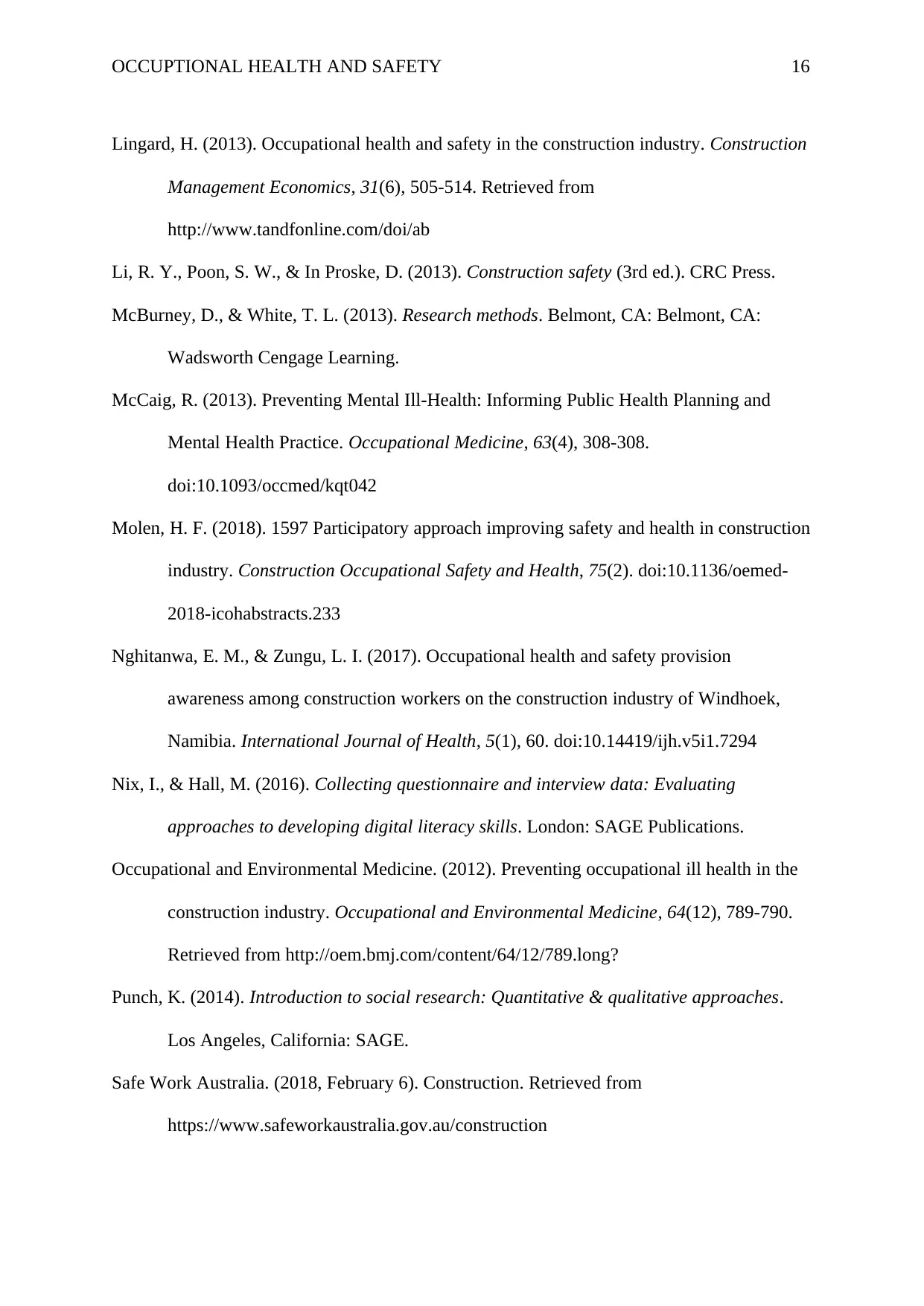
OCCUPTIONAL HEALTH AND SAFETY 16
Lingard, H. (2013). Occupational health and safety in the construction industry. Construction
Management Economics, 31(6), 505-514. Retrieved from
http://www.tandfonline.com/doi/ab
Li, R. Y., Poon, S. W., & In Proske, D. (2013). Construction safety (3rd ed.). CRC Press.
McBurney, D., & White, T. L. (2013). Research methods. Belmont, CA: Belmont, CA:
Wadsworth Cengage Learning.
McCaig, R. (2013). Preventing Mental Ill-Health: Informing Public Health Planning and
Mental Health Practice. Occupational Medicine, 63(4), 308-308.
doi:10.1093/occmed/kqt042
Molen, H. F. (2018). 1597 Participatory approach improving safety and health in construction
industry. Construction Occupational Safety and Health, 75(2). doi:10.1136/oemed-
2018-icohabstracts.233
Nghitanwa, E. M., & Zungu, L. I. (2017). Occupational health and safety provision
awareness among construction workers on the construction industry of Windhoek,
Namibia. International Journal of Health, 5(1), 60. doi:10.14419/ijh.v5i1.7294
Nix, I., & Hall, M. (2016). Collecting questionnaire and interview data: Evaluating
approaches to developing digital literacy skills. London: SAGE Publications.
Occupational and Environmental Medicine. (2012). Preventing occupational ill health in the
construction industry. Occupational and Environmental Medicine, 64(12), 789-790.
Retrieved from http://oem.bmj.com/content/64/12/789.long?
Punch, K. (2014). Introduction to social research: Quantitative & qualitative approaches.
Los Angeles, California: SAGE.
Safe Work Australia. (2018, February 6). Construction. Retrieved from
https://www.safeworkaustralia.gov.au/construction
Lingard, H. (2013). Occupational health and safety in the construction industry. Construction
Management Economics, 31(6), 505-514. Retrieved from
http://www.tandfonline.com/doi/ab
Li, R. Y., Poon, S. W., & In Proske, D. (2013). Construction safety (3rd ed.). CRC Press.
McBurney, D., & White, T. L. (2013). Research methods. Belmont, CA: Belmont, CA:
Wadsworth Cengage Learning.
McCaig, R. (2013). Preventing Mental Ill-Health: Informing Public Health Planning and
Mental Health Practice. Occupational Medicine, 63(4), 308-308.
doi:10.1093/occmed/kqt042
Molen, H. F. (2018). 1597 Participatory approach improving safety and health in construction
industry. Construction Occupational Safety and Health, 75(2). doi:10.1136/oemed-
2018-icohabstracts.233
Nghitanwa, E. M., & Zungu, L. I. (2017). Occupational health and safety provision
awareness among construction workers on the construction industry of Windhoek,
Namibia. International Journal of Health, 5(1), 60. doi:10.14419/ijh.v5i1.7294
Nix, I., & Hall, M. (2016). Collecting questionnaire and interview data: Evaluating
approaches to developing digital literacy skills. London: SAGE Publications.
Occupational and Environmental Medicine. (2012). Preventing occupational ill health in the
construction industry. Occupational and Environmental Medicine, 64(12), 789-790.
Retrieved from http://oem.bmj.com/content/64/12/789.long?
Punch, K. (2014). Introduction to social research: Quantitative & qualitative approaches.
Los Angeles, California: SAGE.
Safe Work Australia. (2018, February 6). Construction. Retrieved from
https://www.safeworkaustralia.gov.au/construction
Secure Best Marks with AI Grader
Need help grading? Try our AI Grader for instant feedback on your assignments.
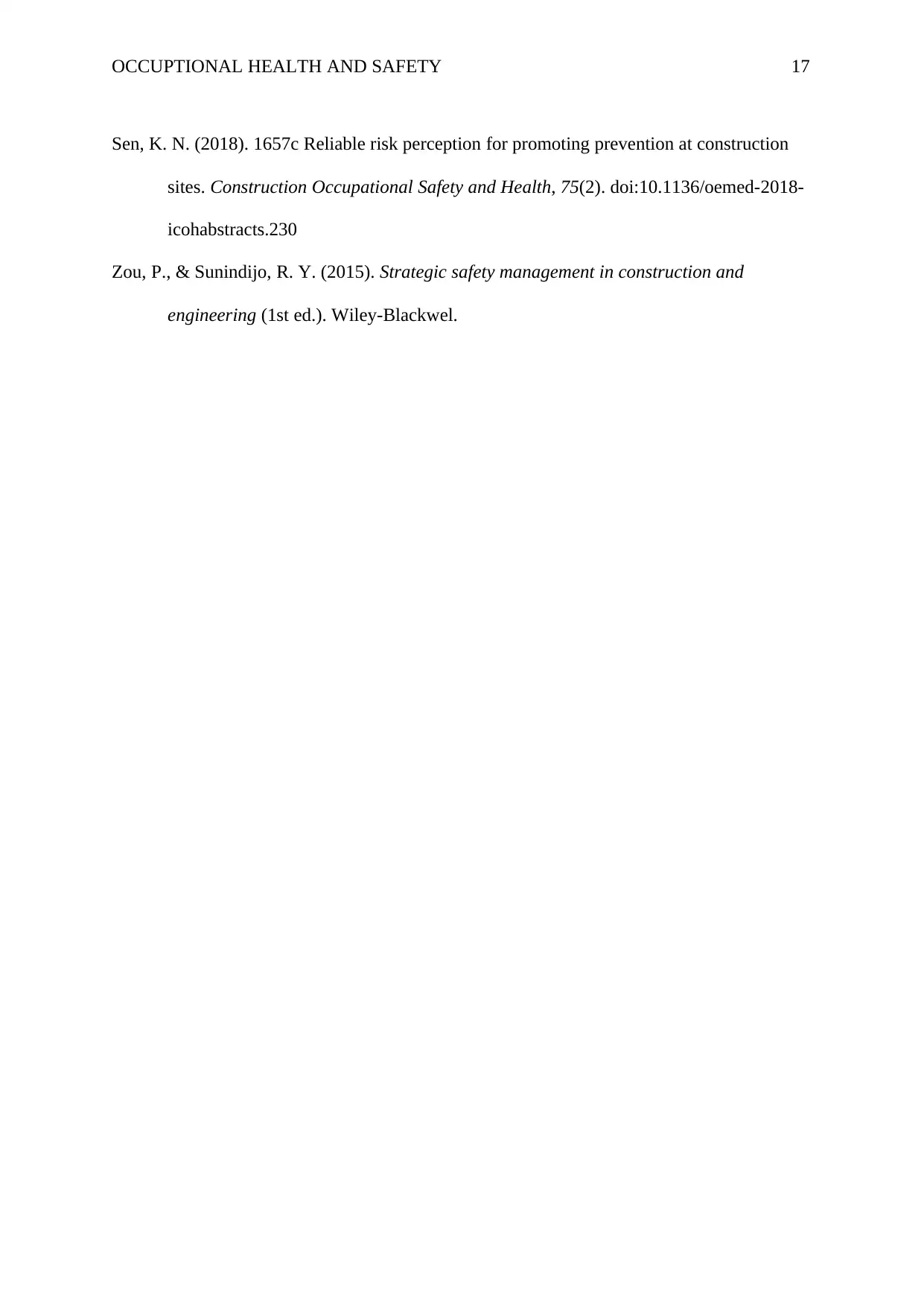
OCCUPTIONAL HEALTH AND SAFETY 17
Sen, K. N. (2018). 1657c Reliable risk perception for promoting prevention at construction
sites. Construction Occupational Safety and Health, 75(2). doi:10.1136/oemed-2018-
icohabstracts.230
Zou, P., & Sunindijo, R. Y. (2015). Strategic safety management in construction and
engineering (1st ed.). Wiley-Blackwel.
Sen, K. N. (2018). 1657c Reliable risk perception for promoting prevention at construction
sites. Construction Occupational Safety and Health, 75(2). doi:10.1136/oemed-2018-
icohabstracts.230
Zou, P., & Sunindijo, R. Y. (2015). Strategic safety management in construction and
engineering (1st ed.). Wiley-Blackwel.
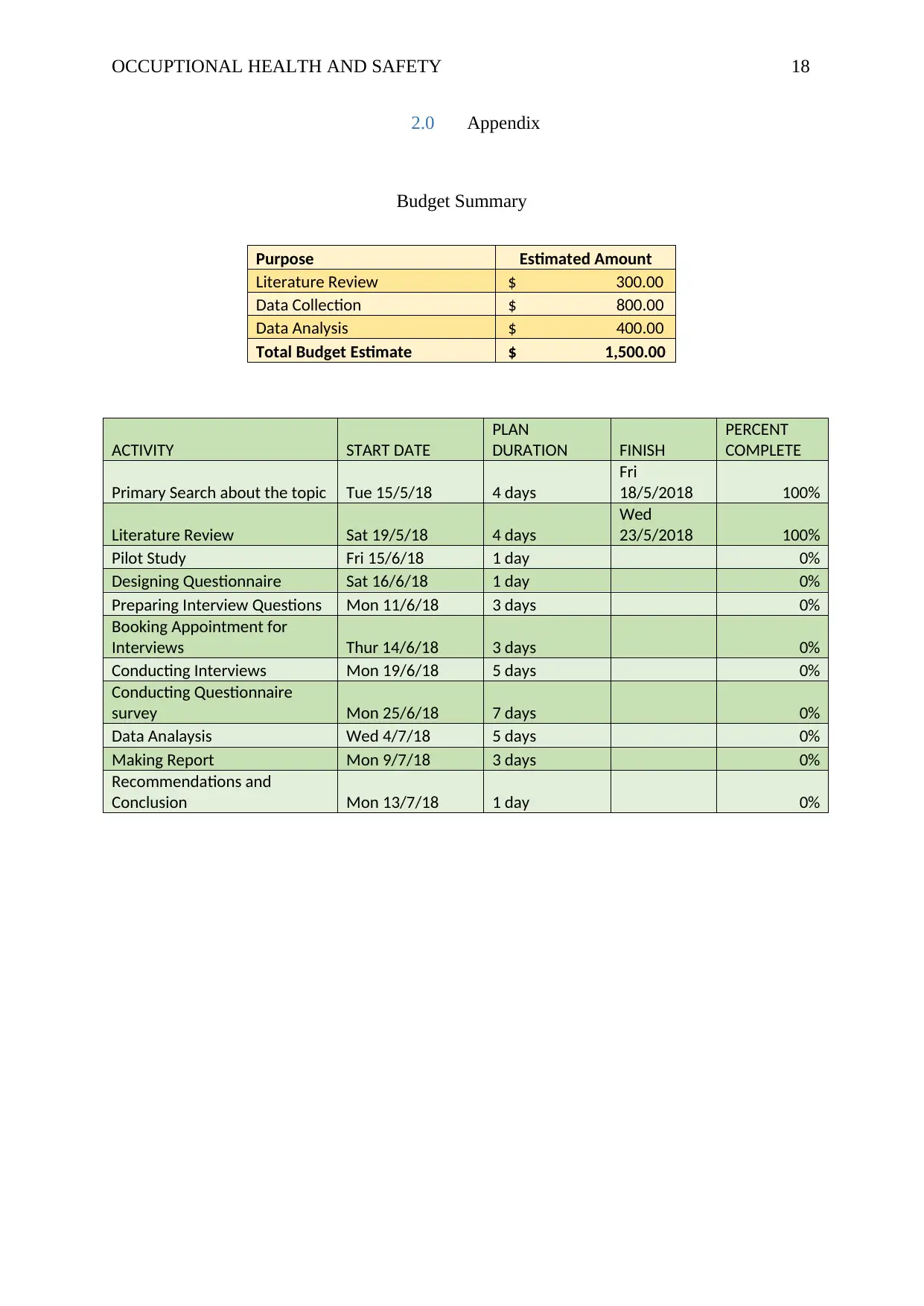
OCCUPTIONAL HEALTH AND SAFETY 18
2.0 Appendix
Budget Summary
Purpose Estimated Amount
Literature Review $ 300.00
Data Collection $ 800.00
Data Analysis $ 400.00
Total Budget Estimate $ 1,500.00
ACTIVITY START DATE
PLAN
DURATION FINISH
PERCENT
COMPLETE
Primary Search about the topic Tue 15/5/18 4 days
Fri
18/5/2018 100%
Literature Review Sat 19/5/18 4 days
Wed
23/5/2018 100%
Pilot Study Fri 15/6/18 1 day 0%
Designing Questionnaire Sat 16/6/18 1 day 0%
Preparing Interview Questions Mon 11/6/18 3 days 0%
Booking Appointment for
Interviews Thur 14/6/18 3 days 0%
Conducting Interviews Mon 19/6/18 5 days 0%
Conducting Questionnaire
survey Mon 25/6/18 7 days 0%
Data Analaysis Wed 4/7/18 5 days 0%
Making Report Mon 9/7/18 3 days 0%
Recommendations and
Conclusion Mon 13/7/18 1 day 0%
2.0 Appendix
Budget Summary
Purpose Estimated Amount
Literature Review $ 300.00
Data Collection $ 800.00
Data Analysis $ 400.00
Total Budget Estimate $ 1,500.00
ACTIVITY START DATE
PLAN
DURATION FINISH
PERCENT
COMPLETE
Primary Search about the topic Tue 15/5/18 4 days
Fri
18/5/2018 100%
Literature Review Sat 19/5/18 4 days
Wed
23/5/2018 100%
Pilot Study Fri 15/6/18 1 day 0%
Designing Questionnaire Sat 16/6/18 1 day 0%
Preparing Interview Questions Mon 11/6/18 3 days 0%
Booking Appointment for
Interviews Thur 14/6/18 3 days 0%
Conducting Interviews Mon 19/6/18 5 days 0%
Conducting Questionnaire
survey Mon 25/6/18 7 days 0%
Data Analaysis Wed 4/7/18 5 days 0%
Making Report Mon 9/7/18 3 days 0%
Recommendations and
Conclusion Mon 13/7/18 1 day 0%
1 out of 18
Related Documents
Your All-in-One AI-Powered Toolkit for Academic Success.
+13062052269
info@desklib.com
Available 24*7 on WhatsApp / Email
![[object Object]](/_next/static/media/star-bottom.7253800d.svg)
Unlock your academic potential
© 2024 | Zucol Services PVT LTD | All rights reserved.





